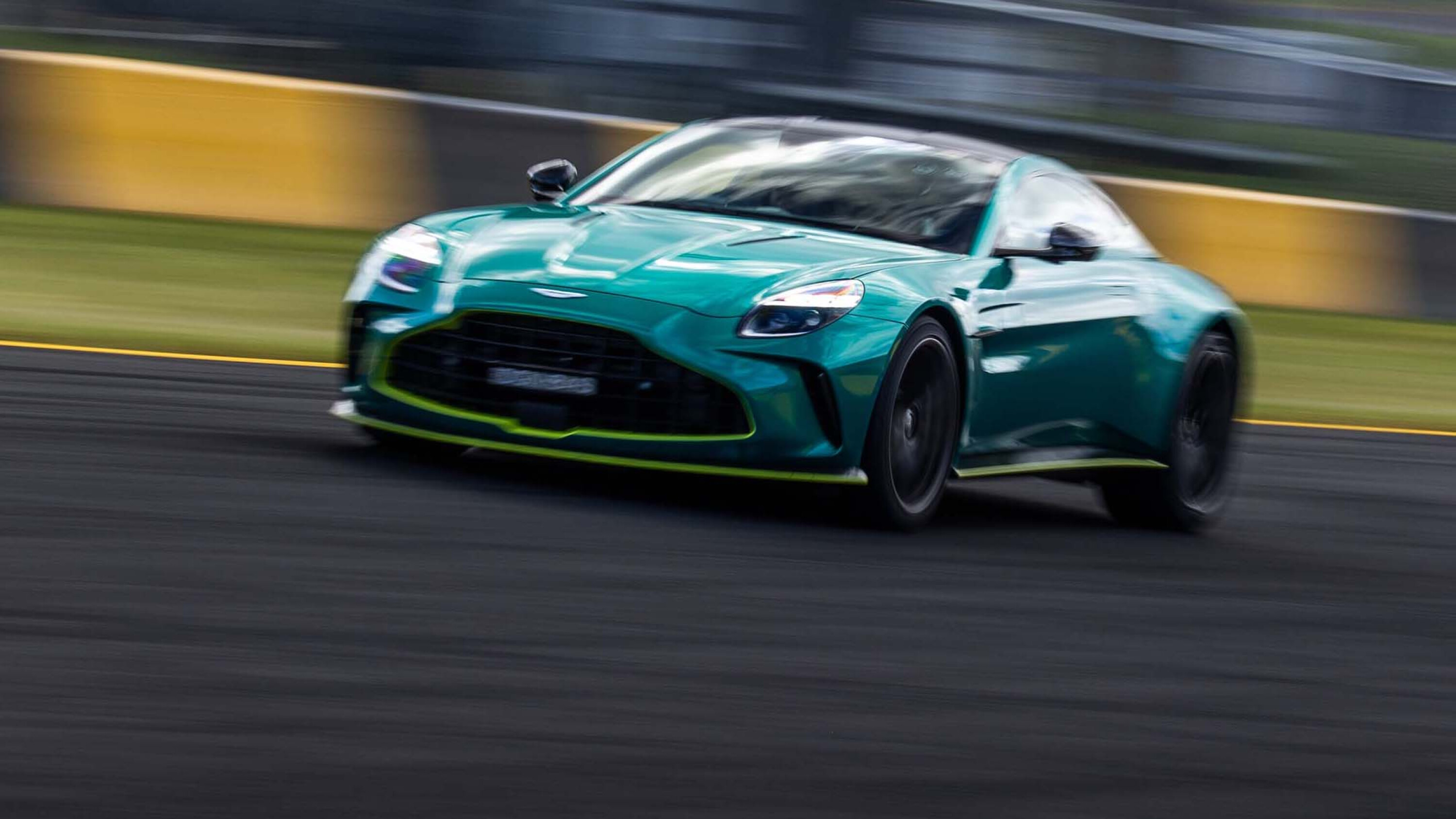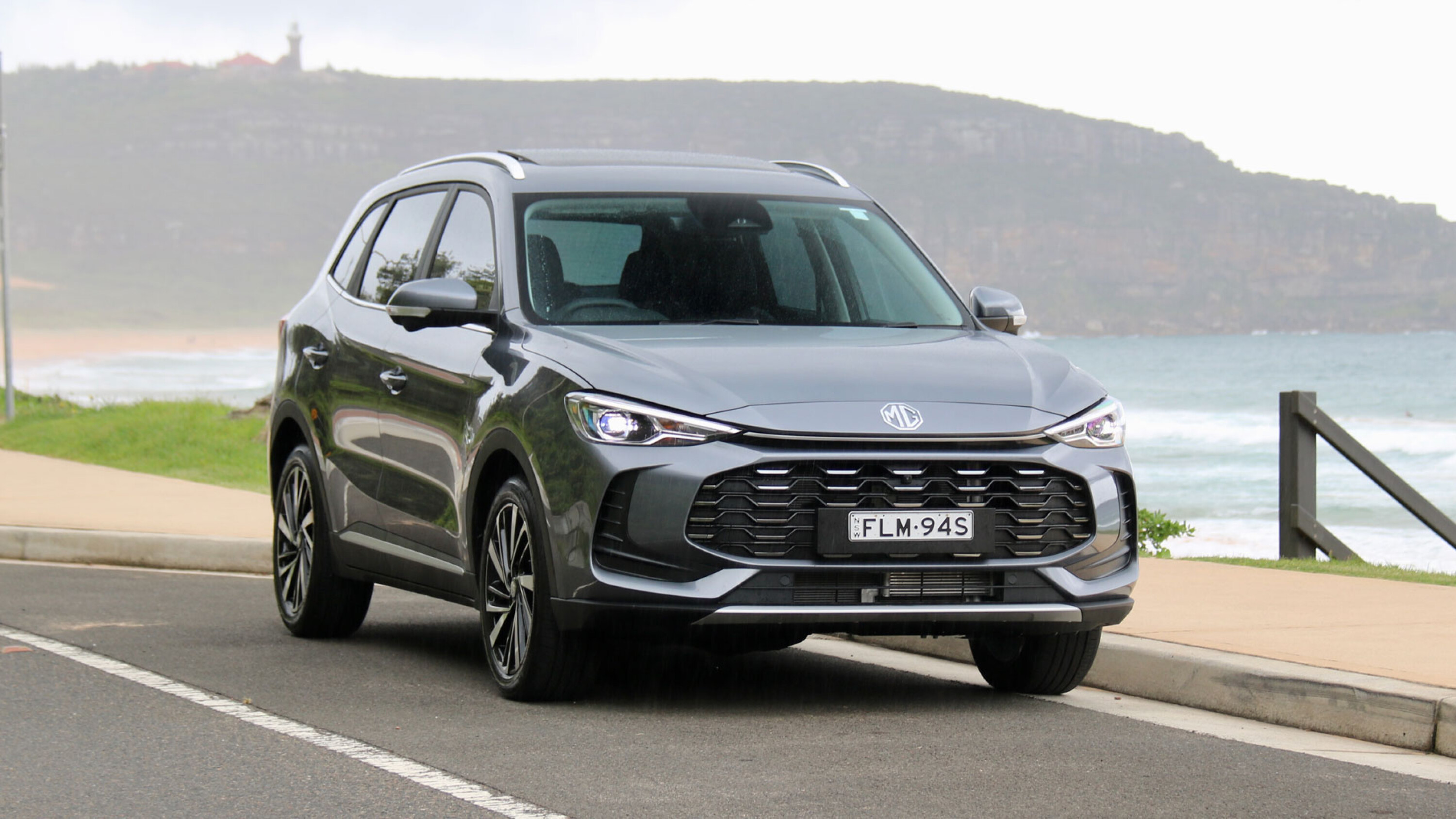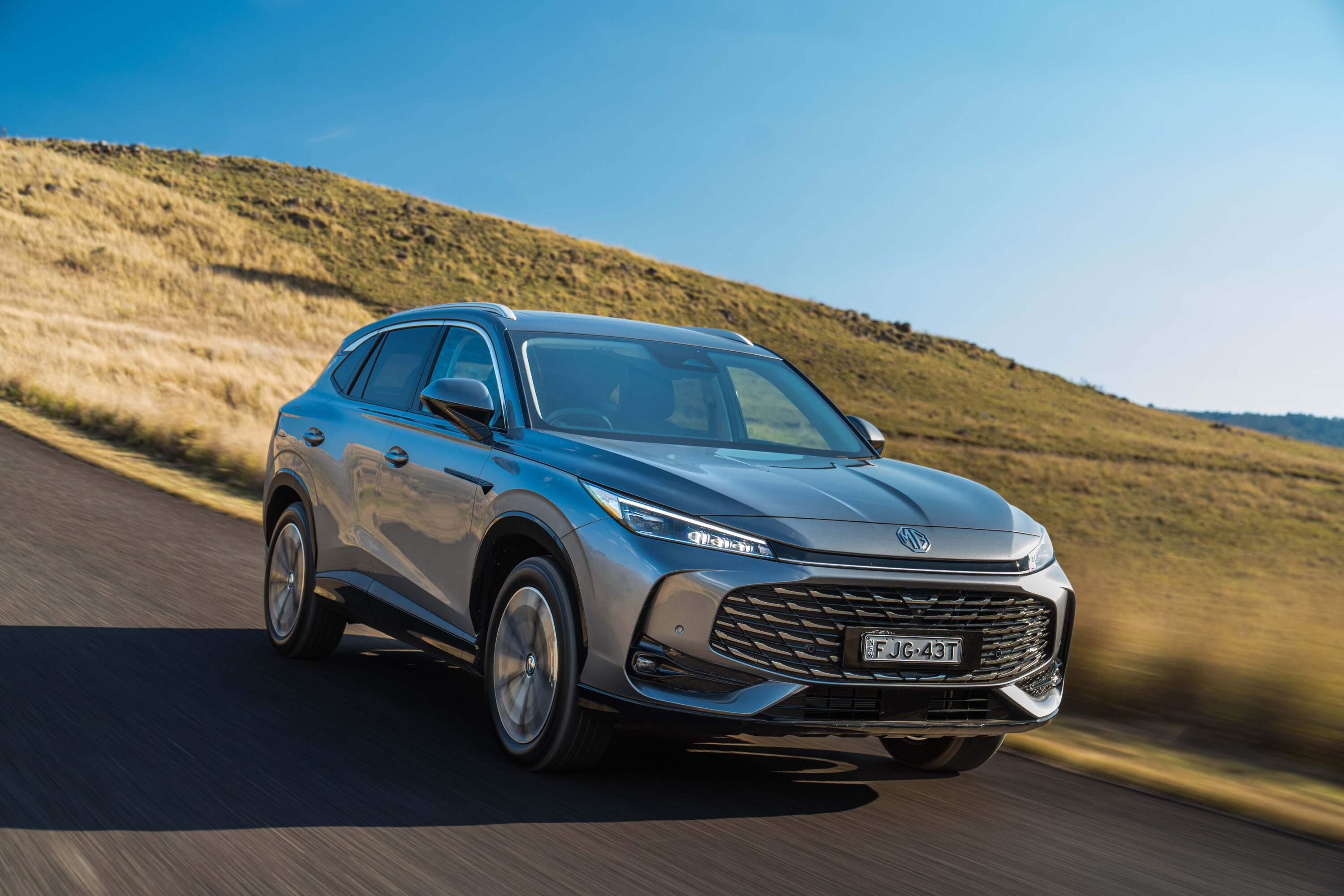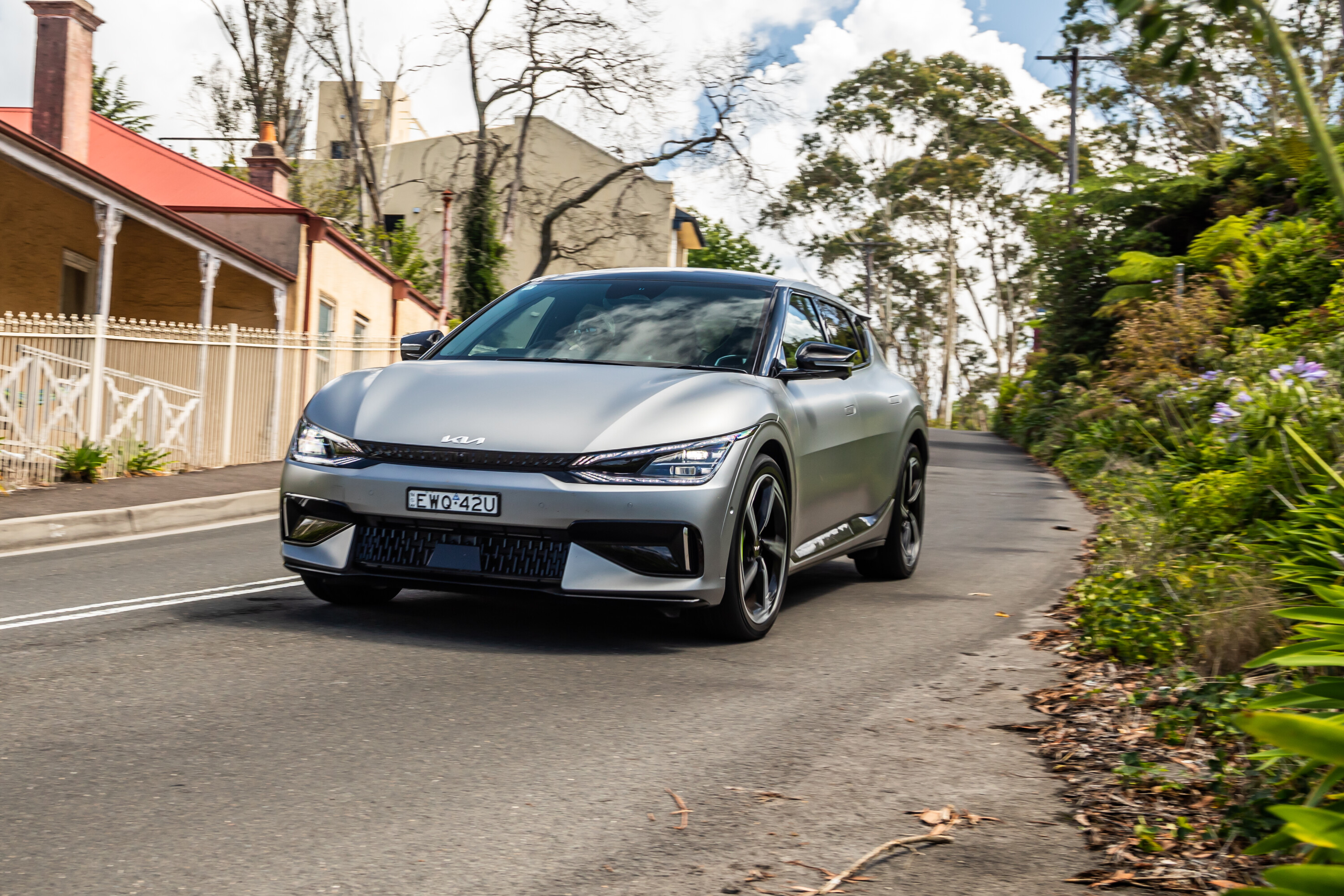
Score breakdown
Things we like
- Sporty, modern design
- Excellent locally-tuned ride and handling
- Good performance, features across the range
- Ultra-rapid charging capability standard
- GT is a ludicrous family-friendly supercar
Not so much
- Pricey $8K jump from GT-Line RWD to AWD
- Flagship GT missing some comfort features
- Boot, headroom could be better
- No advanced app connectivity
The Kia EV6 is a sporty medium electric crossover SUV that represents the automaker’s first ground-up EV and spiritual successor to the short-lived Stinger liftback.
It launched in Australia in early 2022 with three variants, including Air and GT-Line rear-wheel drive (RWD) and GT-Line all-wheel drive (AWD), while the high-powered GT flagship joined the line-up a year later. All models utilise the same battery pack size.
The EV6 adopts the Hyundai Motor Group’s Electric Global Modular Platform (E-GMP), which is shared with the retro-inspired Hyundai Ioniq 5 and upmarket Genesis GV60.
JUMP AHEAD
- Pricing
- What body styles are available for the Kia EV6?
- What features are standard in every Kia EV6?
- What features do I get if I spend more?
- How safe is the Kia EV6?
- How comfortable and practical is the Kia EV6?
- How much boot space does the Kia EV6 offered?
- I enjoy driving – will I enjoy this car?
- Which version of the Kia EV6 provides the longest range?
- What is the Kia EV6’s towing capacity?
- How long is the warranty and What are the Kia EV6’s servicing costs?
- Which version of the Kia EV6 does Wheels recommend?
- What are the Kia EV6’s key rivals?
- What might annoy me?
- Does any upgrade have a down side?
- What might I miss that similar cars have?
- What’s the infotainment system like?
- Where does Kia make the EV6?
- Are there plans to update the Kia EV6 soon?
Pricing
Prices below exclude on-road costs, dealer delivery fees and the Luxury Car Tax (LCT) where applicable.
| 2023 Kia EV6 variant | Price |
|---|---|
| Air | $72,590 |
| GT-Line RWD | $79,590 |
| GT-Line AWD | $87,590 |
| GT | $99,590 |
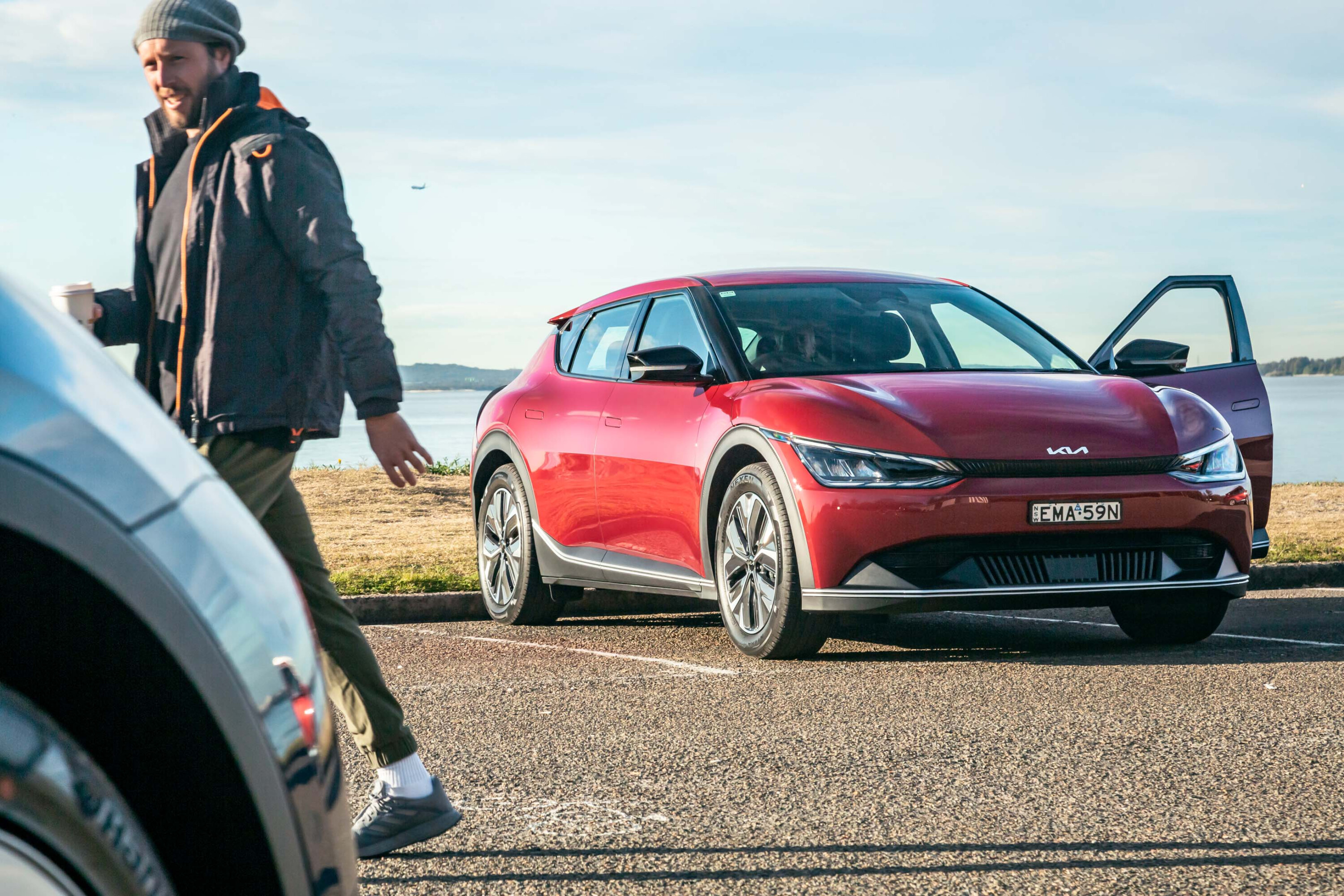
What body styles are available for the Kia EV6?
The Kia EV6 is classed as a five-seater medium SUV.
However, in reality, it appears to be more of a large hatchback (or shorter wagon) with a lower overall height and ground clearance than the petrol- and diesel-powered equivalent Kia Sportage SUV.
| Air | GT-Line RWD | GT-Line AWD | GT | |
|---|---|---|---|---|
| Length | 4680mm | 4695mm | 4695mm | 4695mm |
| Width | 1880mm | 1890mm | 1890mm | 1890mm |
| Height | 1550mm | 1550mm | 1550mm | 1545mm |
| Wheelbase | 2900mm | 2900mm | 2900mm | 2900mm |
| Ground Clearance | 160mm | 160mm | 160mm | 155mm |
| Boot (minimum / rear seats folded) | 490 / 1270-litres | 480 / 1260-litres | 480 / 1260-litres | 480 / 1260-litres |
| Frunk | 52-litres | 52-litres | 20-litres | 20-litres |
| Tare weight | 2000kg | 2000kg | 2105kg | 2185kg |
Table scrolls horizontally to reveal more columns
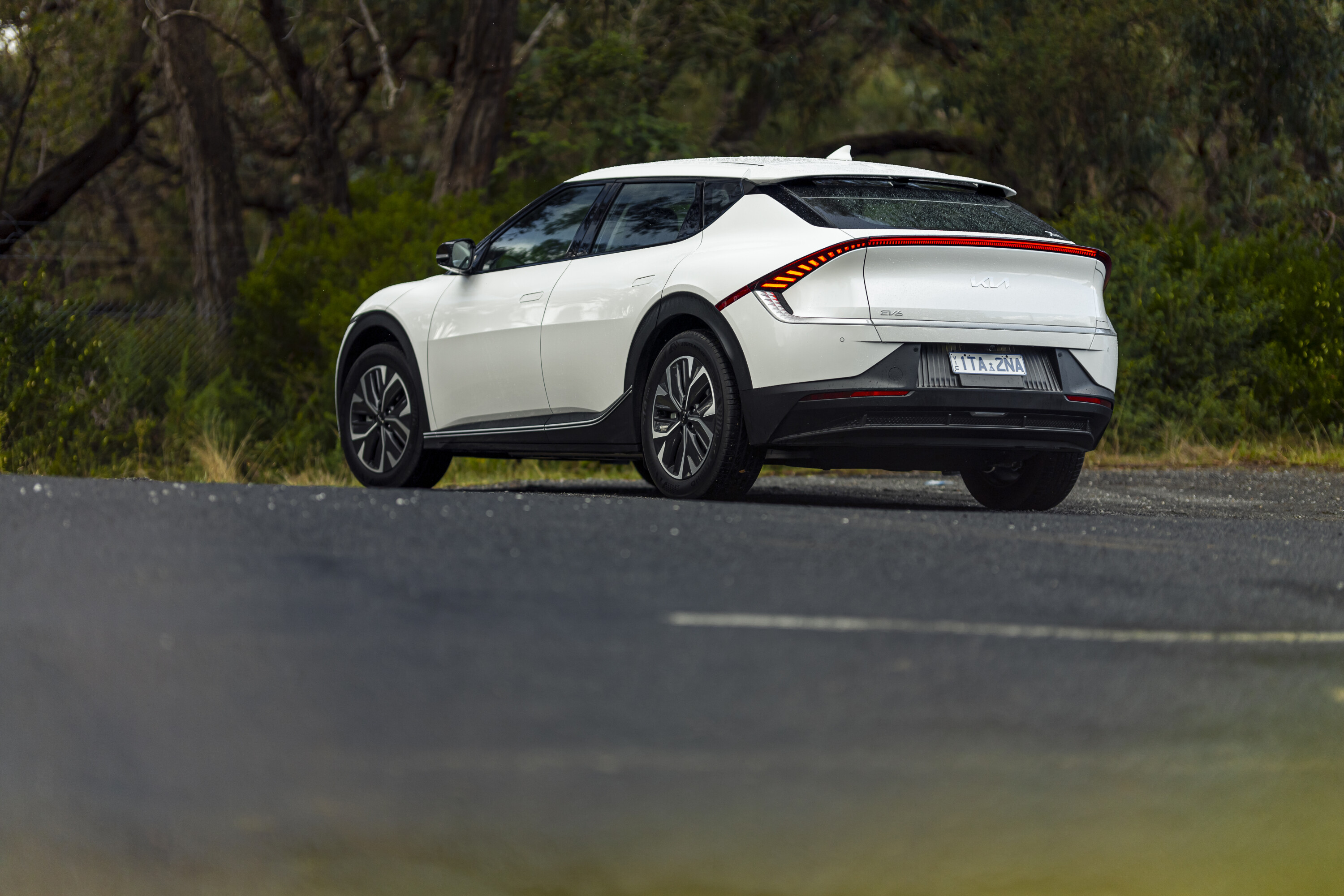
What features are standard in every Kia EV6?
Things we like
- Good standard kit
- Air doesnu2019t have gloss black centre console and door trims
Not so much
- Lower-spec, smaller battery version would help bring down the price
The base Kia EV6 Air is well-featured, with a single electric motor, rear-wheel drive and a 74kWh usable lithium-ion battery.
| 2023 Kia EV6 Air standard features | |
|---|---|
| 19-inch alloy wheels | Cloth and artificial leather seats |
| Full LED head- and tail-lights | Fabric look dashboard with silver metallic interior trim |
| Dual curved 12.3-inch touchscreen and driver instrument displays | Light grey cloth headliner |
| Wired Apple CarPlay and wired Android Auto | Six-way manually adjustable front seats with two-way electric lumbar |
| Built-in maps, AM/FM/DAB radio | Two-spoke artificial leather steering wheel |
| Six-speaker audio | Flush exterior door handles |
| Qi wireless charging pad | Matte plastic wheel arches |
| Interior vehicle-to-load (V2L) plug | Gloss black wing mirrors, pillars and window surrounds |
| 1x USB-A, 4x USB-C, 2x 12-volt charging ports | Acoustic film windscreen, solar glass on windscreen and doors |
| Proximity key with push button start | Dual-zone climate control with rear air vents |
| Interior LED lighting | Manual rear child door locks |
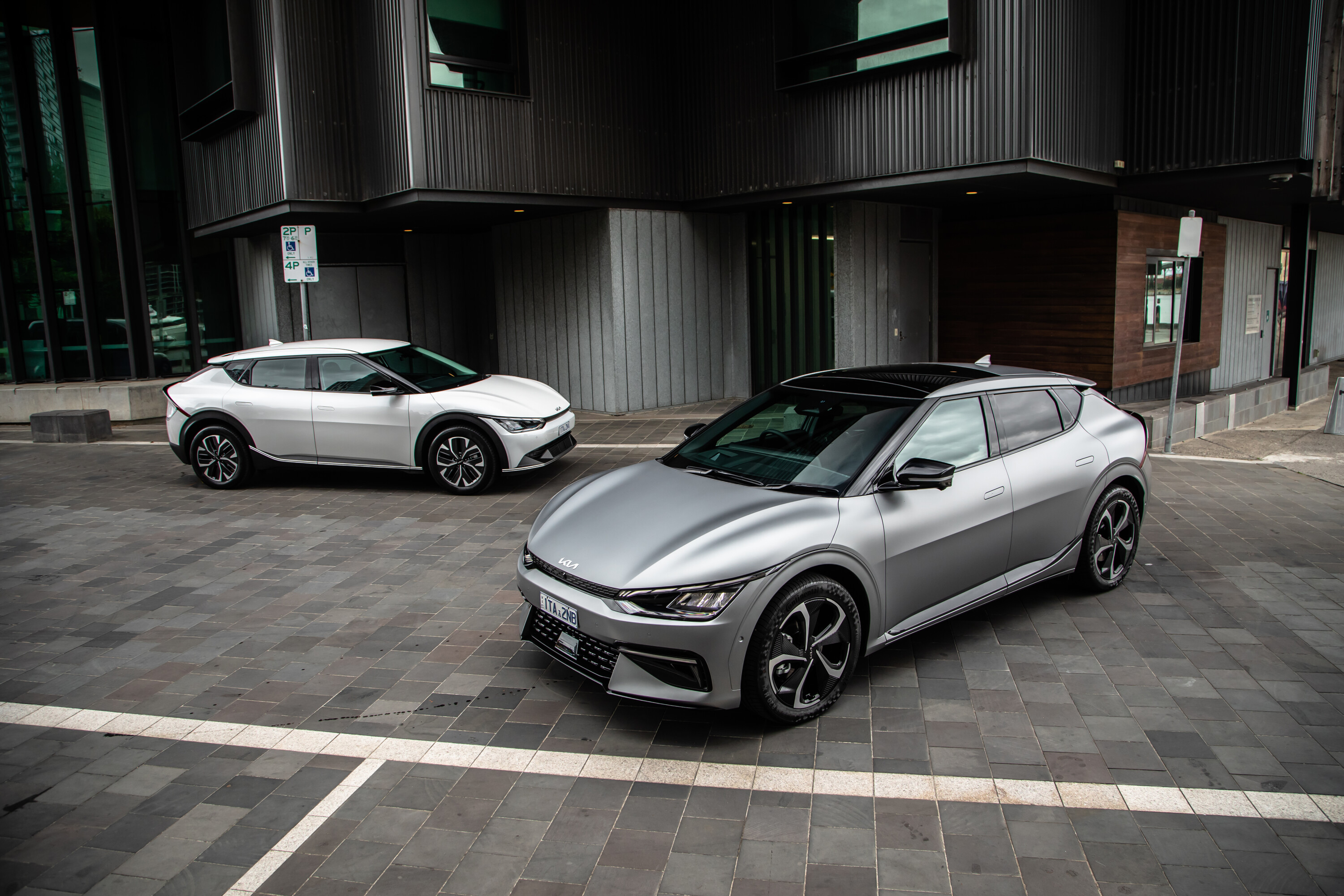
What key features do I get if I spend more?
Things we like
- GT-Line RWD already achieves high spec level
Not so much
- GT-Line AWD doesnu2019t get much for $8K spend over RWD
- GT omits some comfort and convenience features
The mid GT-Line RWD has the same powertrain, but adds more comfort and convenience features.
| GT-Line RWD adds | |
|---|---|
| 20-inch alloy wheels | Artificial black suede/white leather seats |
| GT-Line exterior body design with body-coloured wheel arches | GT-Line pattern dashboard with gloss black interior trim |
| Augmented reality head-up display | Black cloth headliner |
| 64-colour ambient interior lighting | Eight-way electrically adjustable front seats |
| 14-speaker Meridian Premium branded audio system | Heated and ventilated front seats with relaxation mode |
| Exterior V2L (via included Type 2 adapter) | Two-position driveru2019s seat memory |
| Active Sound Design driving noises | Heated steering wheel |
| Remote smart parking assist | Manually reclining rear seats (60:40 split) |
| Auto pop in/out flush door handles | Laminated front door windows |
| Hands-free electric tailgate | Tinted rear privacy glass |
| Luggage net | Alloy pedals and metal scuff plates |
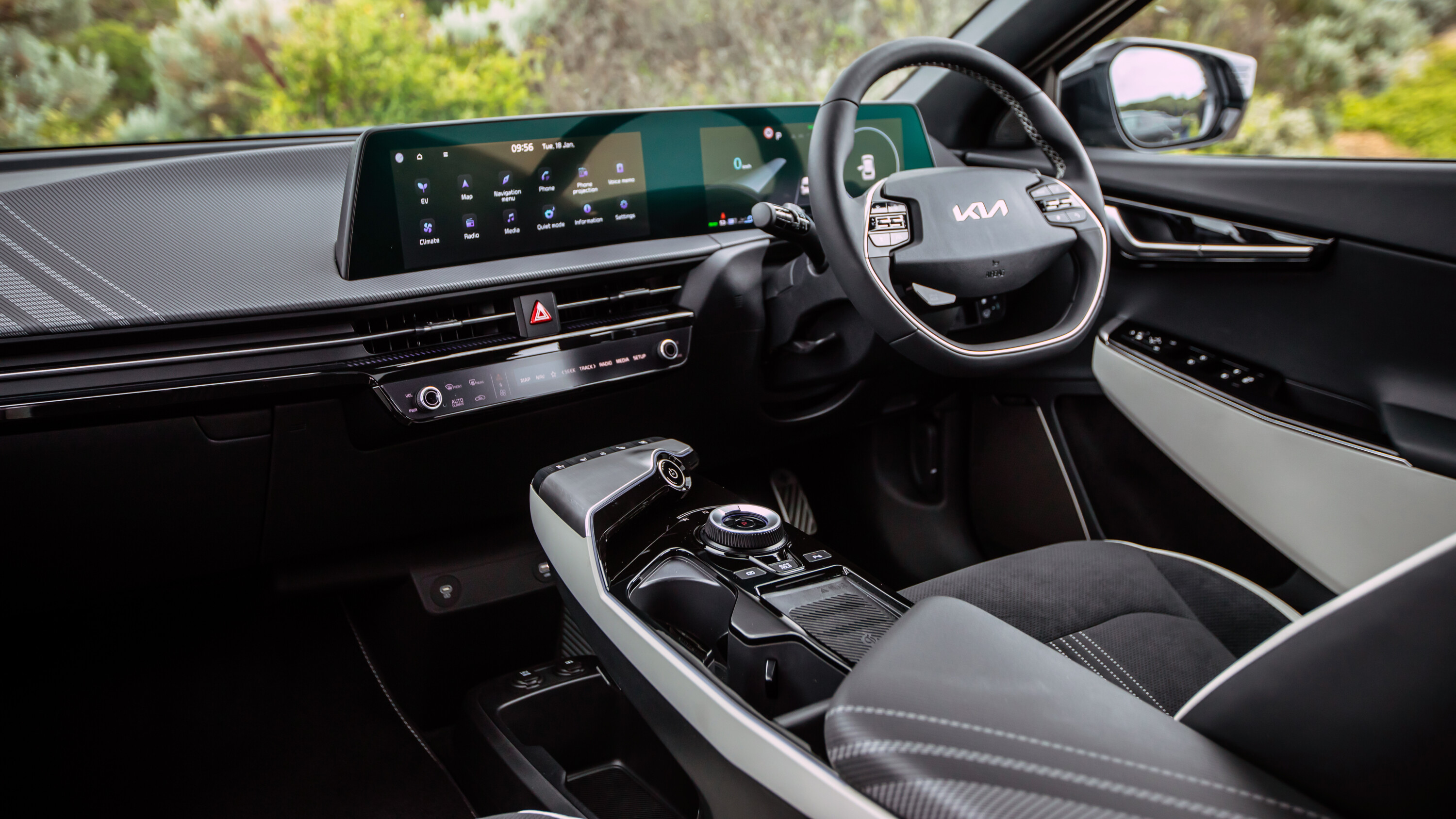
The GT-Line AWD gets a more powerful dual-motor setup for all-wheel drive, plus one additional feature.
| GT-Line AWD adds | |
|---|---|
| u2018Wideu2019 sunroof |
The flagship GT gets a hyper dual electric motor tune, but removes on some equipment.
| GT adds | ||
|---|---|---|
| 21-inch alloy wheels with Michelin Pilot Sport 4S tyres | Artificial suede and leather front bucket seats* | |
| Neon green painted brake callipers | Six-way manually adjustable heated front seats* | |
| GT exterior body design | Neon green stitched and piped seats with artificial suede door trim | |
| GT driving mode | Heated rear outer seats | |
| Electrically-limited slip differential | Adaptive matrix LED high beam headlights | |
| Electrically controlled suspension | Sequential front and rear turn indicators | |
| 380mm front and 360mm rear ventilated disc brakes | ||
| *Compared to the GT-Line, the EV6 GT removes front seat electric adjustment, lumbar support, ventilation, relaxation mode, and driveru2019s seat memory. | ||
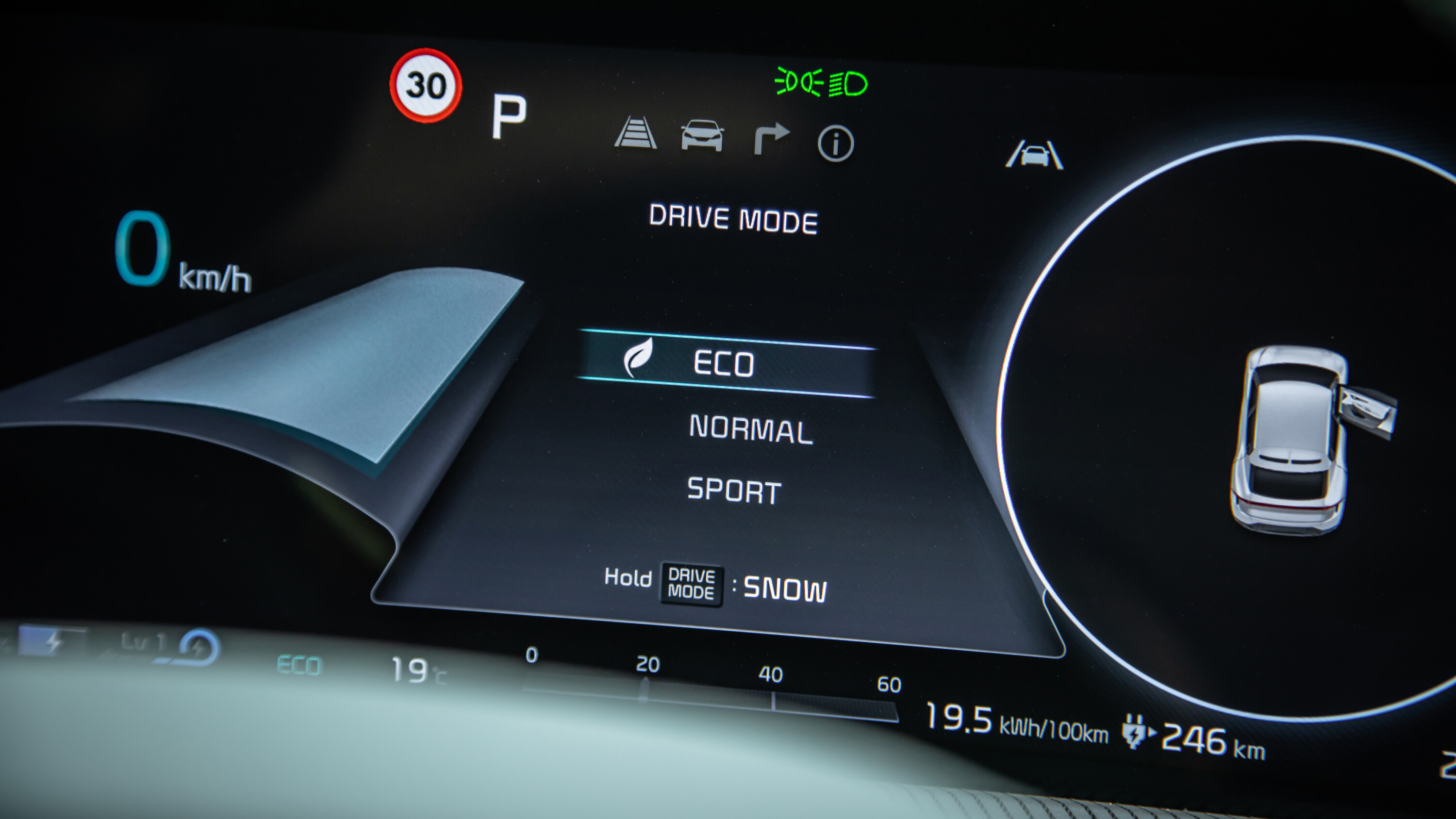
2023 Kia EV6 options
| 2023 Kia EV6 exterior colours | |
|---|---|
| Runway Red | Standard |
| Yacht Blue | $520 |
| Snow White Pearl | $520 |
| Aurora Black Pearl | $520 |
| Glacier (Air only) | $520 |
| Steel Grey (Air only) | $520 |
| Moonscape Grey Matte (GT-Line and GT only) | $3295 |

How safe is the Kia EV6?
Things we like
- Full 2022 ANCAP rating
- Most safety assist tech standard
Not so much
- Only $100K GT has adaptive matrix headlights
The Kia EV6 achieved the full five-star safety rating by the Australasian New Car Assessment Program (ANCAP) [↗] under the 2022 testing criteria. However, the flagship GT is unrated.
Individual assessment scores included: 90 per cent adult occupant protection, 87 per cent child occupant protection, 64 per cent vulnerable road user protection, and 88 per cent for safety assist systems.
All EV6 models feature eight airbags, including a centre airbag, plus two ISOFIX and three top-tether child seat anchor points at the rear row.
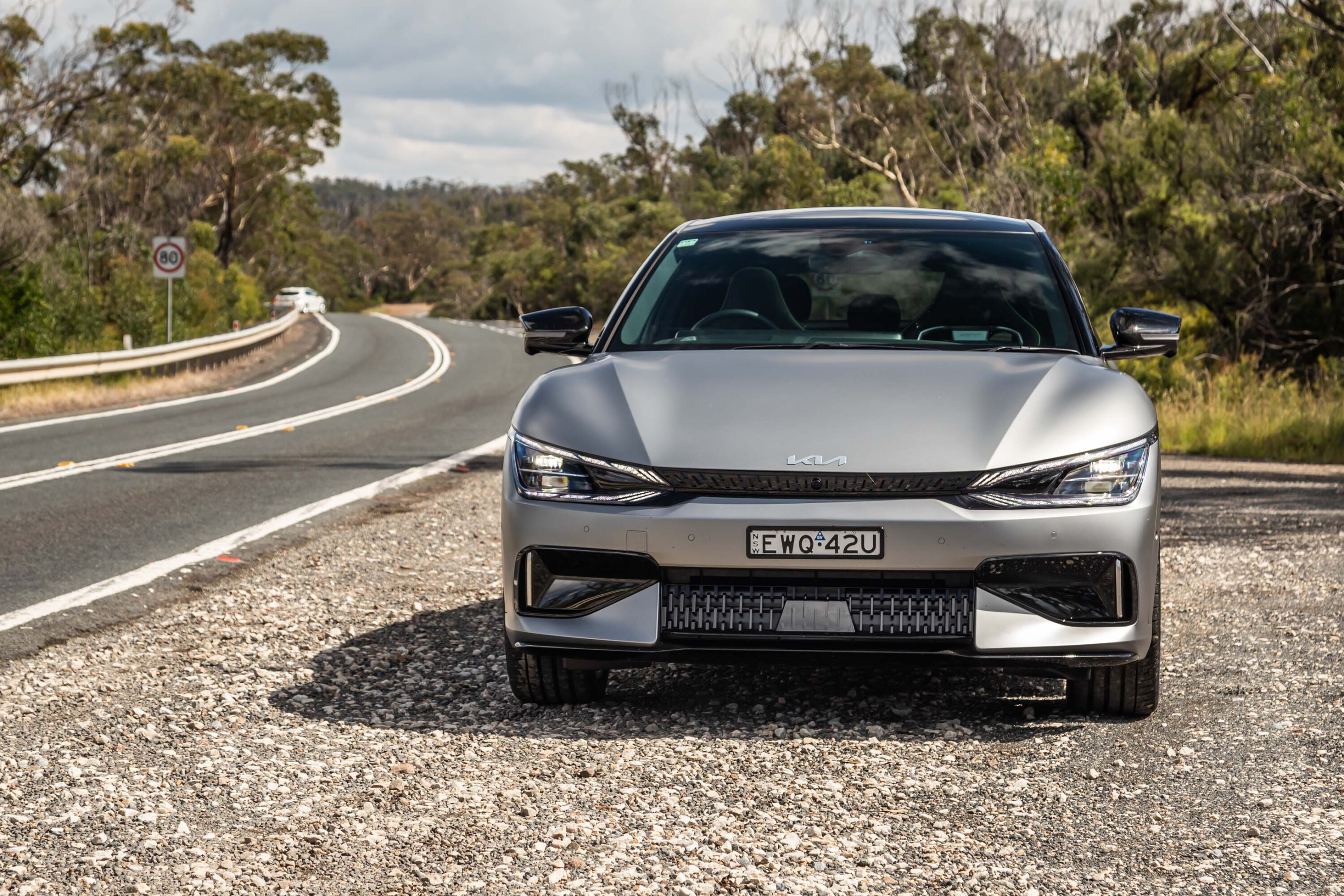
The entry-level EV6 Air, which comes standard with most active safety assistance technologies, uses a combination of camera and radar sensors.
| 2023 Kia EV6 Air standard safety assist features | |
|---|---|
| Front auto emergency braking (AEB) with vehicle/pedestrian/cyclist/intersection turning detection | Reversing camera |
| Lane-keep and lane-centring assist | Front and rear parking sensors |
| Blind-spot assist | Rear occupant alert |
| Rear cross-traffic assist | Safe exit door warning |
| Adaptive cruise control | Driver attention monitoring |
| Lead vehicle departure alert | Auto high beam LED headlights |
| Speed limit assist (based on built-in map data) | Manual rear child door locks |
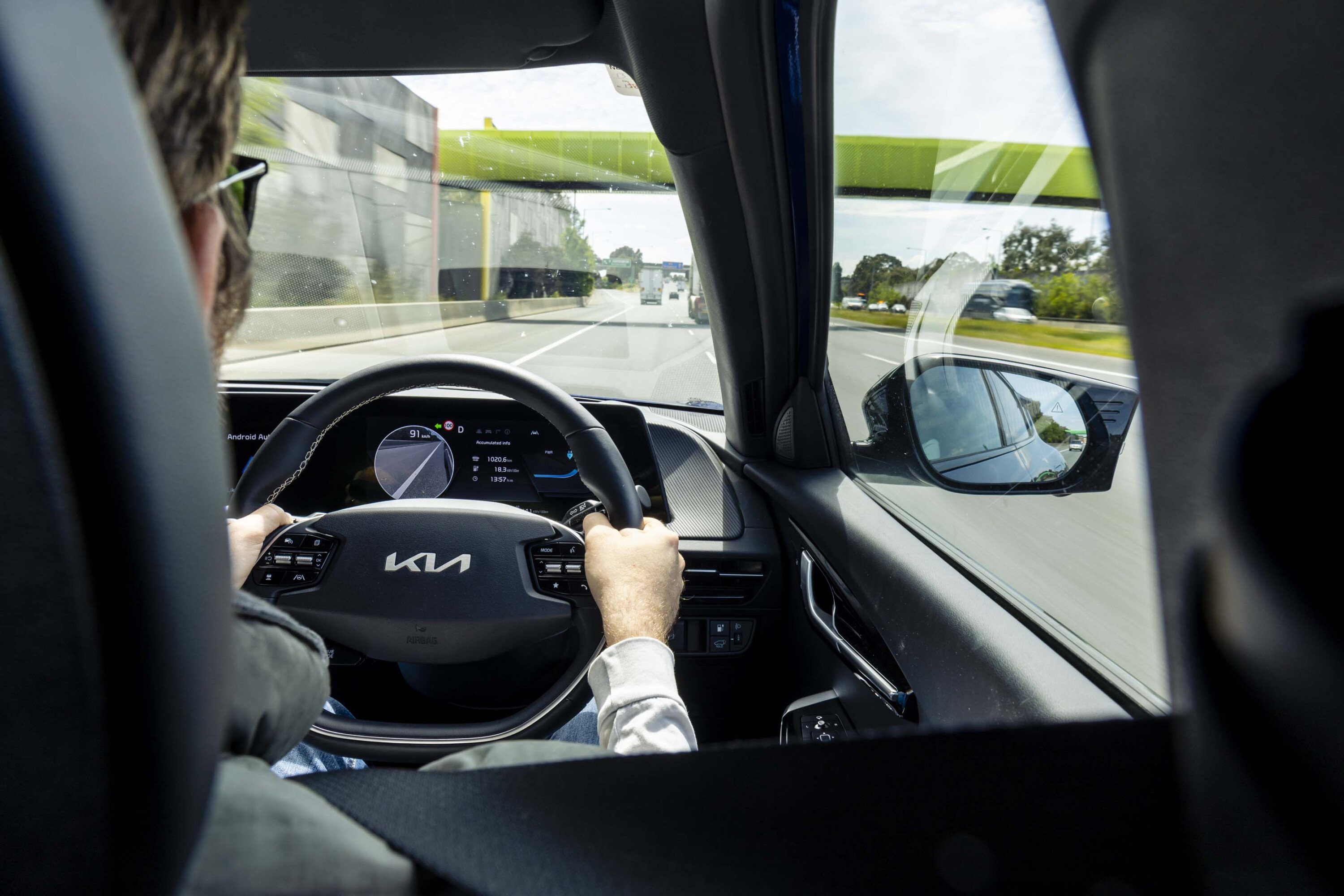
GT-Line variants add more safety assist tech.
| GT-Line RWD/AWD adds | |
|---|---|
| Rear AEB | Safe exit assist |
| 360-degree camera system | Electric rear child door locks |
| Blind-spot view cameras | |
The top-spec GT exclusively includes a useful feature for night-time driving.
| GT adds | |
|---|---|
| Adaptive matrix LED headlights |

How comfortable and practical is the Kia EV6?
Things we like
- Spacious interior thanks to EV platform
- Comfy seats, especially on GT-Line
Not so much
- Limited headroom due to lower roof
- GT removes seat comfort and convenience features
The Kia EV6’s five-seat interior is generally comfortable thanks to the well-packaged ground-up E-GMP underpinnings, but the sporty design emphasis has some compromises.
We found that the GT-Line’s animal-free suede and leather seats were most supportive, with the front seats benefiting from full electric adjustment, heating and ventilation functionality.
Meanwhile, the entry-level Air’s cloth and artificial leather combo was harder than desirable. The flagship GT, while it has heated rear outer seats, only has manually-adjustable front bucket seats that are firmer, but still supportive.
There is good legroom for rear passengers, well-positioned B-pillar air vents, and a flat floor, though there’s less space to stretch your feet underneath the front seats.
The lower roof and higher seating position also means front occupants feel particularly closer to the ceiling
For families, the EV6 offers two ISOFIX and three top-tether child seat anchors at the rear row. But, it would be uncomfortable to fit two adults plus a child’s car seat for more than a short journey.
The lower roof and higher seating position also means front occupants feel particularly closer to the ceiling and sun visors. GT-Line and GT models also have a darker headliner, the sunroof doesn’t extend to the rear row, and no model has built-in rear sunshades.
Fortunately, there are sizable felt-lined door bottle pockets, a large undertray and armrest storage at the centre console, and a deep glovebox.

How much boot space does the Kia EV6 offer?
Things we like
- Decent boot volume
- Light manual tailgate on Air
- Remote fold-down seat toggles
Not so much
- Restricted usable boot due to lower roof
- Limited underfloor storage
- Tiny frunk on AWD versions
The Kia EV6 Air’s boot measures in at 490-litres, while GT-Line and GT models have 10-litres less volume due to the added hardware of the Meridian-branded speakers.
For context, the combustion-engine equivalent Sportage offers 543-litres with all seats in place.
The EV6’s rear seats can be folded in a 60:40 split using remote release levers, yielding a maximum cargo volume of 1270 litres for the Air model, or 1260 litres for all other variants.
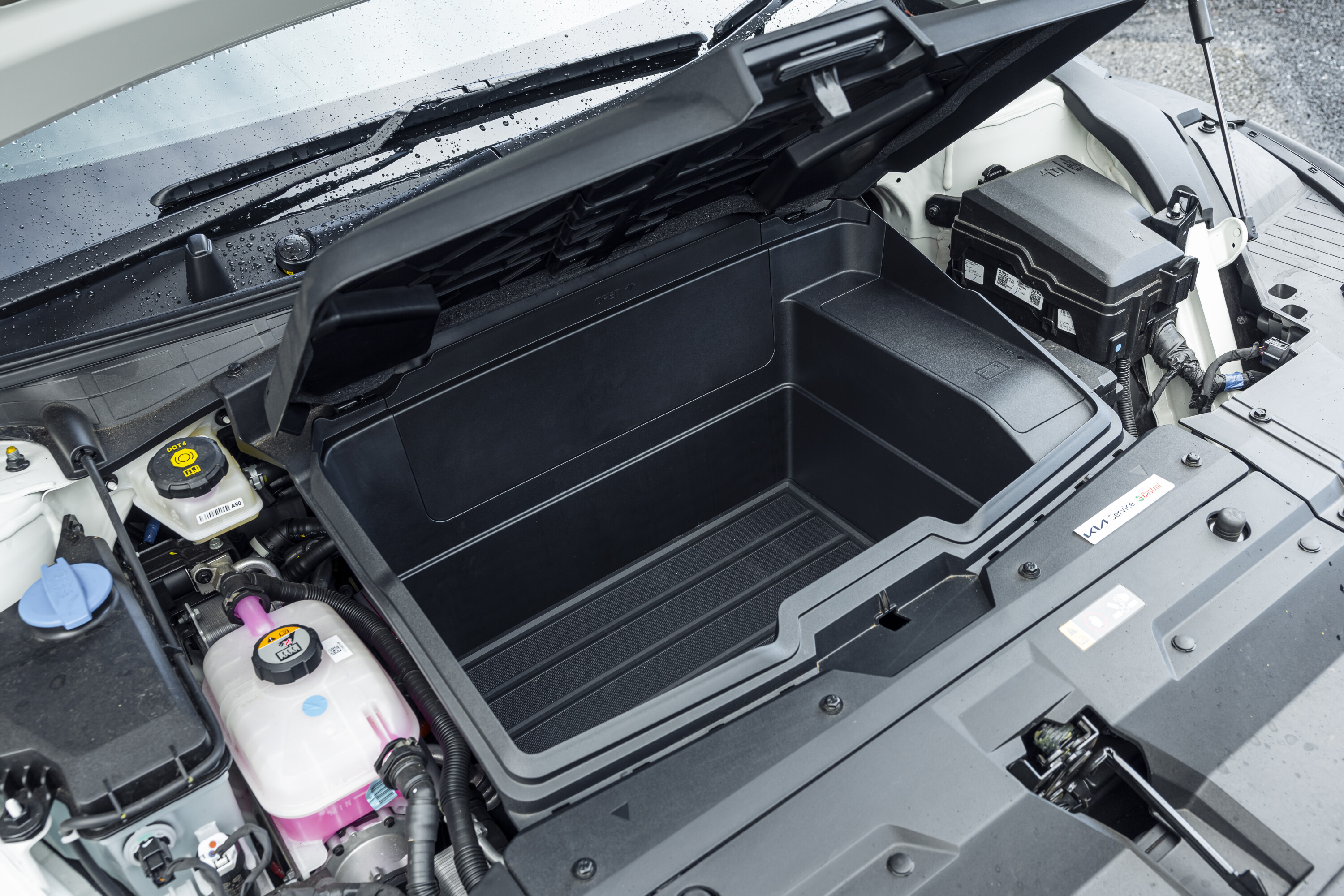
Unfortunately, the sloping rear roofline means the boot volume is less usable in practice with limited underfloor space (especially on AWD versions), a small luggage net (included on GT-Line and GT), and no bag hooks.
Only the GT-Line and GT trims come with a hands-free electric tailgate, which opens after you stand behind the boot for a few seconds. This is instead of a kick sensor. But the door is light enough to easily pull down on the base Air.
The single-motor Air and GT-Line RWD provide a 52-litre frunk storage compartment under the bonnet, which can handily store charging cables or dirty items, while the dual-motor GT-Line AWD and GT are restricted to a shallower 20-litre frunk.
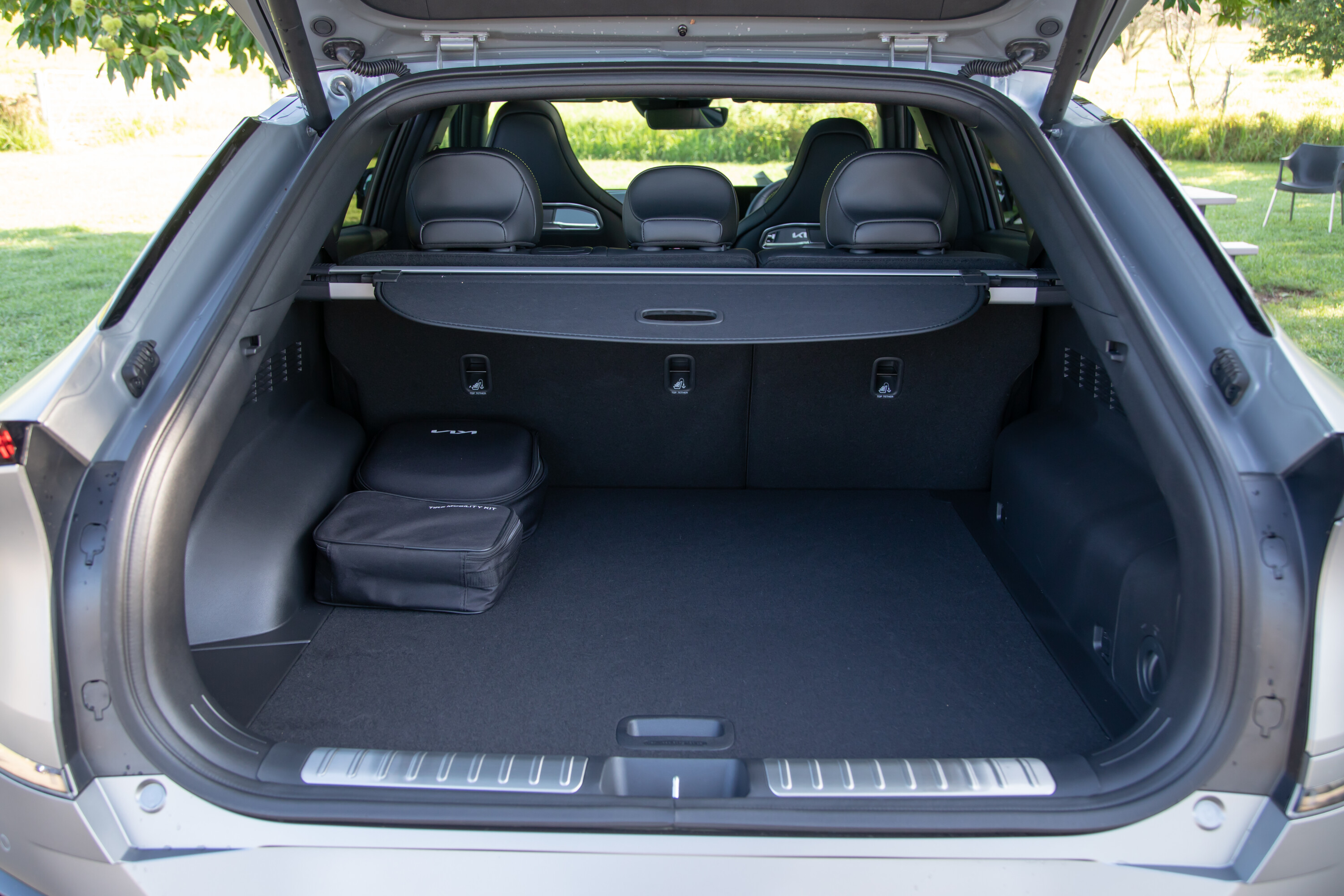
I like driving – will I enjoy this car?
Things we like
- Good performance, NVH across the range
- Fantastic locally-tuned ride and handling
- Selectable regen braking modes
Not so much
- GTu2019s power difficult to truly exploit on public roads
- i-Pedal doesnu2019t keep the brake lights on itself
The entire EV6 range will suit drivers with sharp handling, spritely performance, and a comfortable ride.
Unlike most other new EVs, the EV6 benefits from a bespoke Australian ride and handling tune, featuring ZF Sachs adaptive dampers across the line-up, while the hi-po GT gains an electronic rear limited-slip differential, electronic controlled suspension, and larger ventilated disc brakes.
The electric crossover masks its circa-2000kg weight mostly well in daily driving, with minimal body lean, grippy handling, and a refined ride that soaks up Australia’s rough roads, bumps and undulations well.
Even on the GT with its 21-inch rims and low-profile sports tyres, the ride is firm – but not crashy – and still provides good noise and vibration isolation.
| Air | GT-Line RWD | GT-Line AWD | GT | |
|---|---|---|---|---|
| Power | 168kW | 168kW | 239kW | 430kW |
| Torque | 350Nm | 350Nm | 605Nm | 740Nm |
| 0-100km/h time | 7.3 seconds | 7.3 seconds | 5.2 seconds | 3.5 seconds |
| Drive | RWD | RWD | AWD | AWD |
Table scrolls horizontally to reveal more columns
Even on the entry-level single-motor powertrain on the Air and GT-Line RWD, it’s spritely enough for everyday commuting with requisite instant electric torque at any speed.
Stepping up to the dual-motor GT-Line AWD provides the neck-breaking thrust feel, while having all-wheel drive traction to keep things in check – at the expense of increased energy consumption.
The flagship GT ups the ante of the twin motor outputs to be heart-inducing. But unfortunately, you’ll rarely utilise its full potential legally on most public roads.
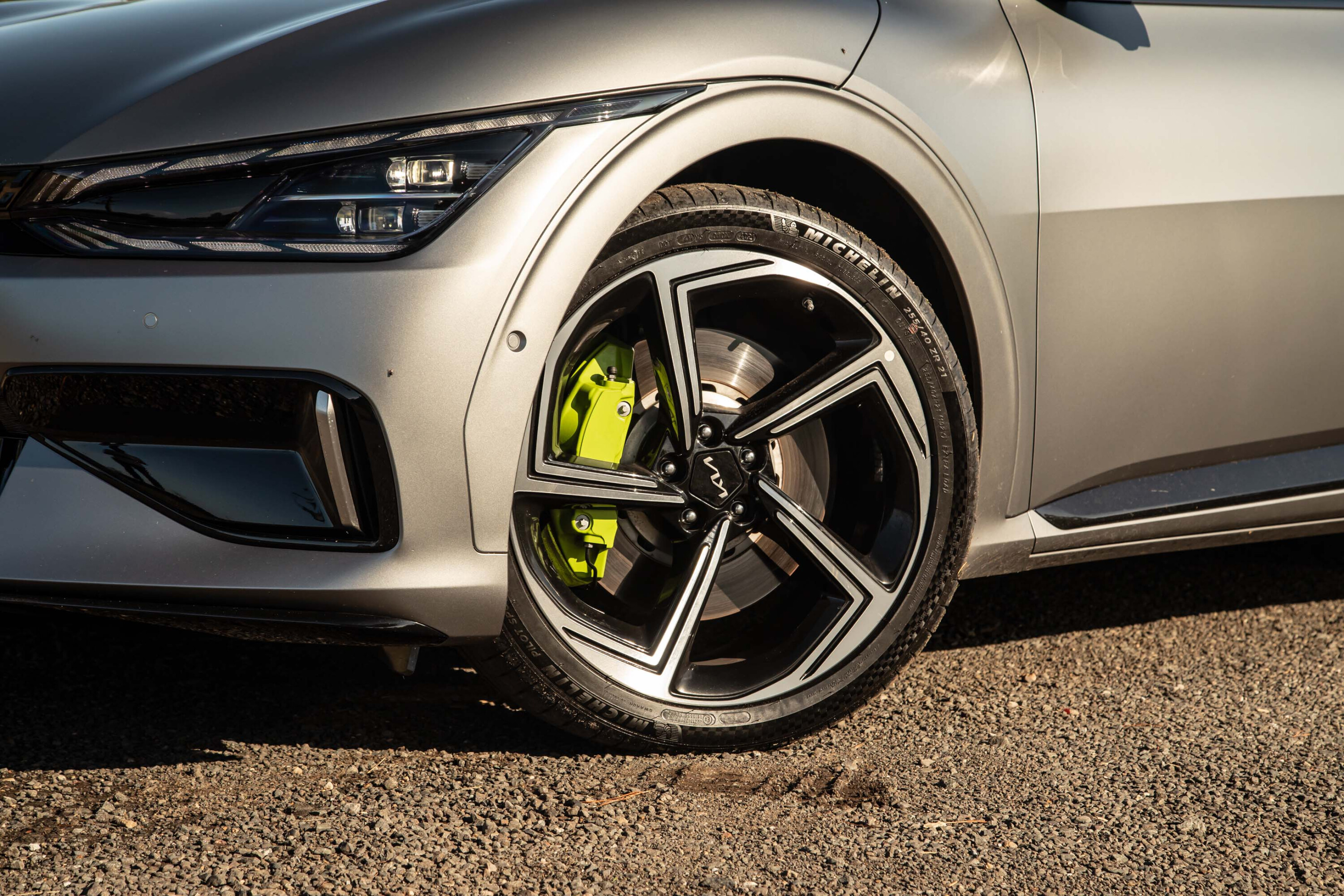
Be aware that the brake lights don’t stay illuminated once at a complete stop
The battery also needs to be above 80 per cent (considered unhealthy if left in extended periods) and in an optimum temperature range to extract maximum power. A preconditioning toggle is offered, but only available if the battery is higher than 70 per cent.
All EV6’s come with four-stage regenerative braking intensities that’s changeable via the steering wheel paddles.
This includes automatic modes and the maximum ‘i-Pedal’ for one-pedal driving. However, please be aware that the brake lights don’t stay illuminated once at a complete stop, so drivers still need to press the brake pedal.
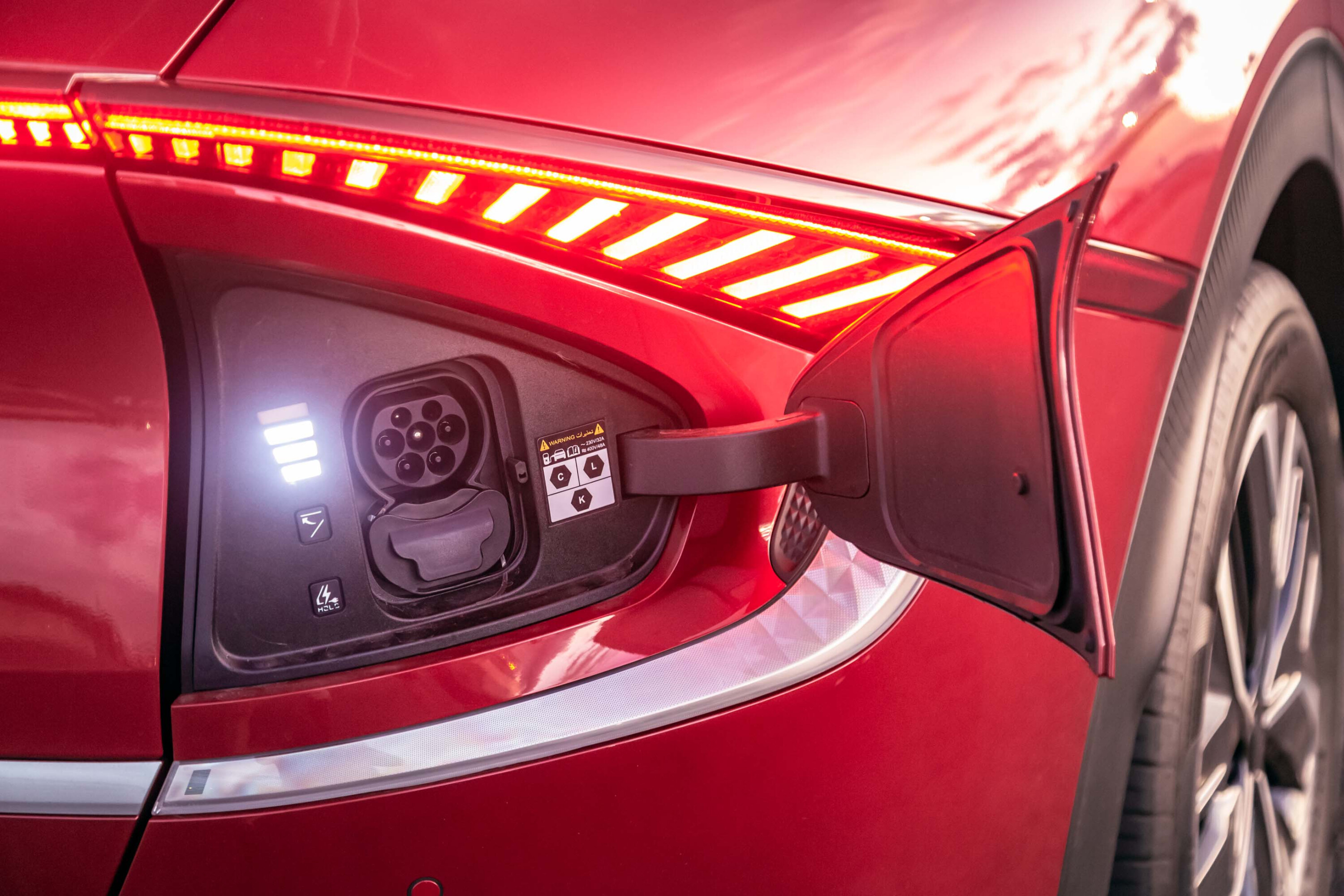
Which version of the Kia EV6 provides the longest range?
Things we like
- Base model is the longest range
- Ultra-rapid DC charging capability standard
Not so much
- AWD models donu2019t get a larger battery to compensate for increased energy consumption
The entry-level Kia EV6 Air provides the longest driving range, with up to 528 kilometres claimed from a full charge and 16.5kWh/100km energy efficiency on the combined WLTP cycle.
We found the Air’s real-world range to be closer to 480km instead with a 16.8kWh/100km tested consumption figure.
The higher up the EV6 rankings, the lower the driving range – with all sharing the same 74kWh usable lithium-ion battery pack.

| Air | GT-Line RWD | GT-Line AWD | GT | |
|---|---|---|---|---|
| Claimed driving range (WLTP combined) | 528km | 504km | 484km | 424km |
| Claimed energy efficiency (WLTP combined) | 16.5kWh/100km | 17.2kWh/100km | 18.0kWh/100km | 20.6kWh/100km |
| Usable battery size (net) | 74kWh | 74kWh | 74kWh | 74kWh |
| Max AC slow charging speed | 10.5kW | 10.5kW | 10.5kW | 10.5kW |
| Max DC fast charging speed | 350kW | 350kW | 350kW | 350kW |
| Recommended charging limit | 80% | 80% | 80% | 80% |
Table scrolls horizontally to reveal more columns
While the GT-Line RWD shares the same powertrain as the Air, its larger wheels mean it increases energy consumption and delivers less total range.
Similarly, the dual-motor GT-Line AWD is another step down in efficiency, with the hi-po GT naturally being the lowest-range EV6 model.
In our experience of more spirited Sunday driving with the EV6 GT, we achieved about 350km real-world range by consuming 21.1kWh/100km.
Thankfully, all Kia EV6 models can recharge at up to 10.5kW AC and 350kW DC speeds – the latter tends to peak around 240kW in reality when connected to a compatible 800-volt class ultra-rapid charging station under optimum temperatures.
What’s the charging limit?
While Kia doesn’t explicitly state a charging limit recommendation, generally, the lithium-ion battery type means everyday recharging should be capped at 80 per cent to maintain good health – unless fully recharging is necessary, such as when on a road trip where you’ll quickly use up the energy.
Keeping the battery in a too high or low battery percentage for extended periods shortens its lifespan, along with frequent DC fast charging.
In this case, the South Korean carmaker claims it can replenish from 10 to 80 per cent in about 18 minutes.
However, keep in mind that most public fast chargers in Australia are limited to 50kW DC, which means the same recharge would take around 73 minutes.
Of course, charging at home is most ideal – a standard AC home plug at around 2kW can take about three full nights to go up to 80 per cent, while using an installed 7kW single-phase or 11kW three-phase AC wall box guarantees it in one night.

What is the Kia EV6’s towing capacity?
Things we like
- Decent towing capabilities
Not so much
- Limited payload
- Expect a noticeable range hit
All Kia EV6 models are rated to tow up to 750kg with an unbraked trailer. Air and GT-Line variants can lug 1600kg, whereas the GT is capable of 1800kg on a braked trailer.
However, the maximum payload is limited to 435kg on all models. That the figure doesn’t account for the maximum 100kg tow ball download weight.
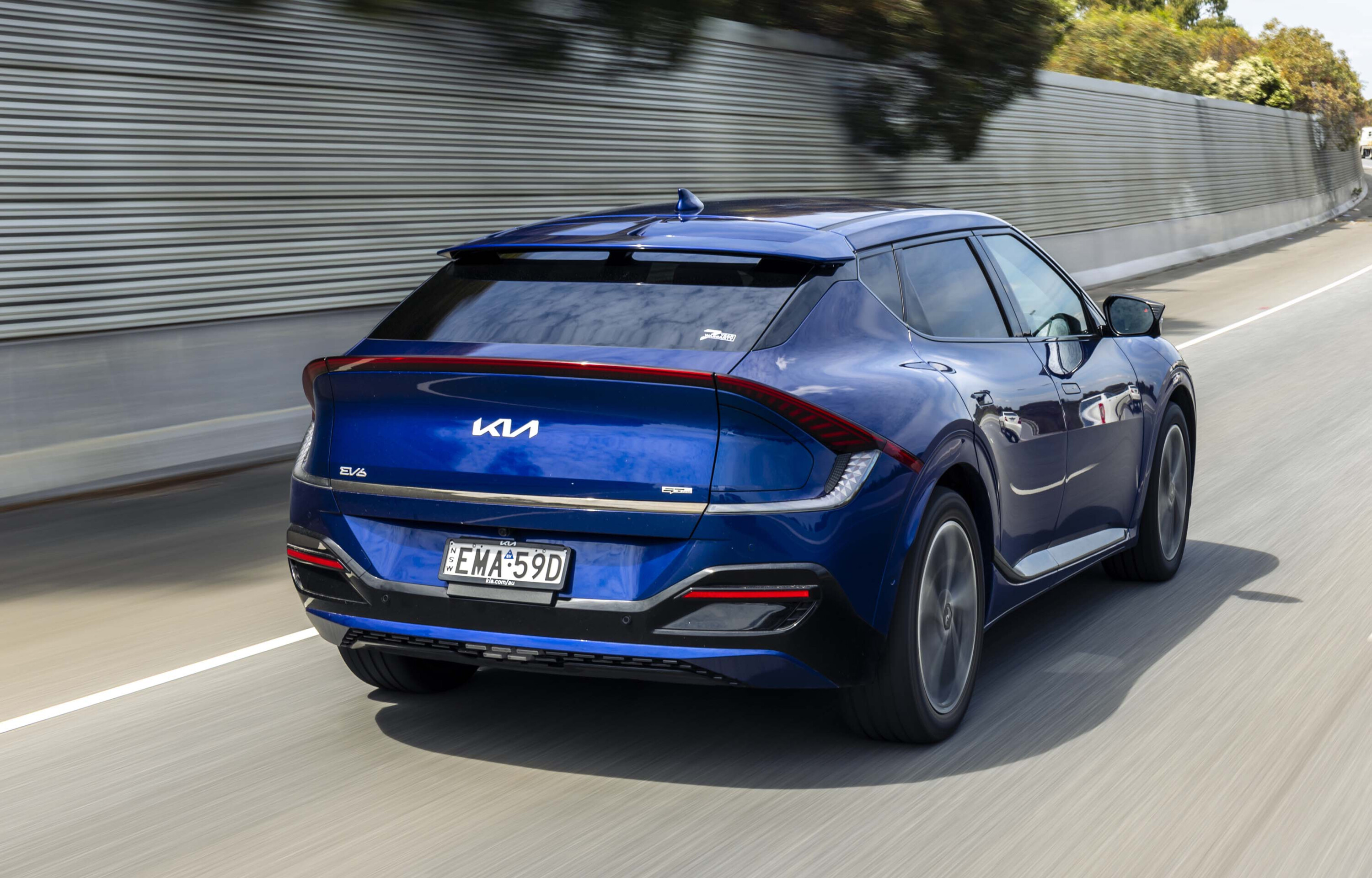
Kia sells a genuine towbar kit accessory for $1418.23, including fitment costs.
As per all EVs, the payload is restricted due to the heavy battery underneath – and expect a significant driving range drop of up to 50 per cent when towing at maximum capacity.
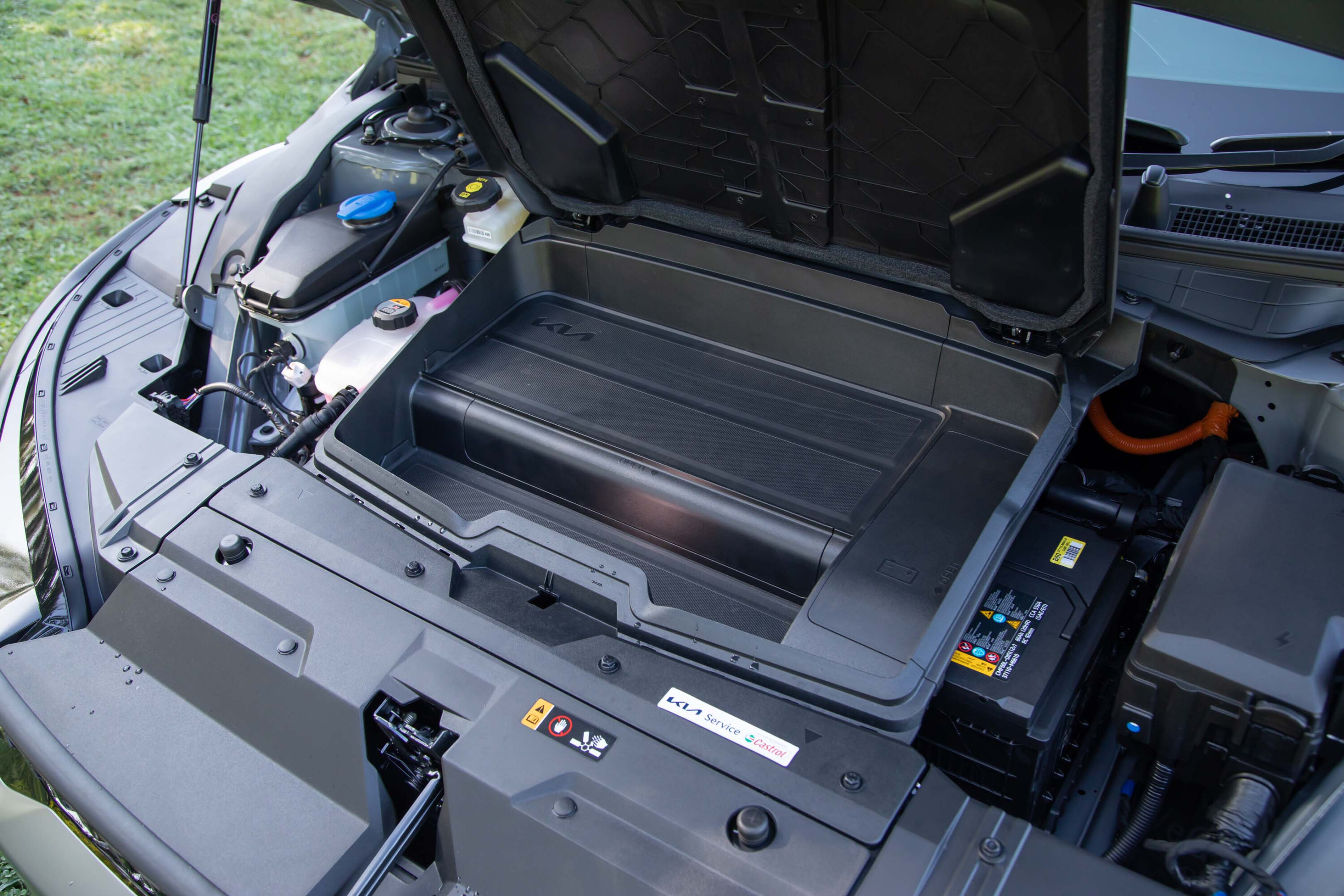
How long is the warranty and what are the Kia EV6’s servicing costs?
Things we like
- Long vehicle warranty
- Servicing costs cheaper than comparable combustion engine SUV
Not so much
- Sub-par battery warranty coverage
- Typical servicing intervals
- Pre-paid servicing doesnu2019t save money
The Kia EV6 is backed by a seven-year/unlimited kilometre vehicle warranty and a seven-year/150,000km battery warranty.
The dedicated battery warranty covers for manufacturing defects and promises to retain at least 70 per cent health during the coverage period.
Servicing is required every 12 months or every 15,000km, with capped prices applicable for the first seven visits only. Roadside assistance is included for up to eight years, provided you service it with Kia on time.
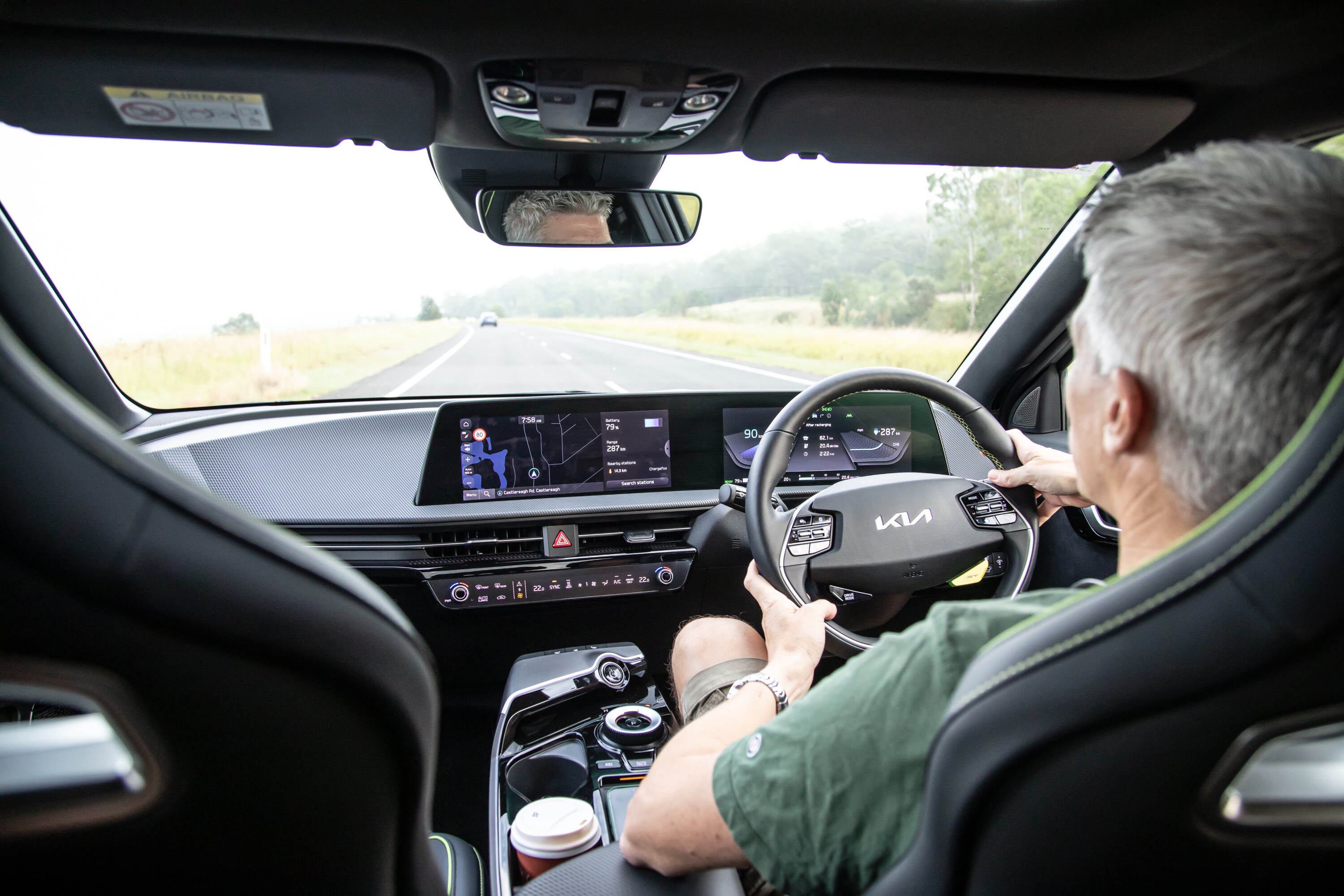
While the company doesn’t officially list capped-price servicing costs for pure EVs on its website, Kia Australia confirmed the following to Wheels.
| 2023 Kia EV6 capped-price servicing costs | Air, GT-Line RWD/AWD | GT |
|---|---|---|
| 1 year/15,000km | $129 | $129 |
| 2 years/30,000km | $333 | $472 |
| 3 years/45,000km | $132 | $132 |
| 4 years/60,000km | $358 | $501 |
| 5 years/75,000km | $136 | $136 |
| 6 years/90,000km | $354 | $501 |
| 7 years/105,000km | $141 | $141 |
It’s not exactly cheaper to opt for pre-paid servicing – unless a $1 saving counts
Additionally, Kia also offers three-, five- and seven-year pre-paid servicing plans priced at $594, $1089 and $1584 respectively. For the GT, it’s pricier at $733, $1371 and $2013 respectively.
Strangely, it’s not exactly cheaper to opt for pre-paid servicing – unless a $1 saving counts by opting for five- or seven-year pre-paid servicing.
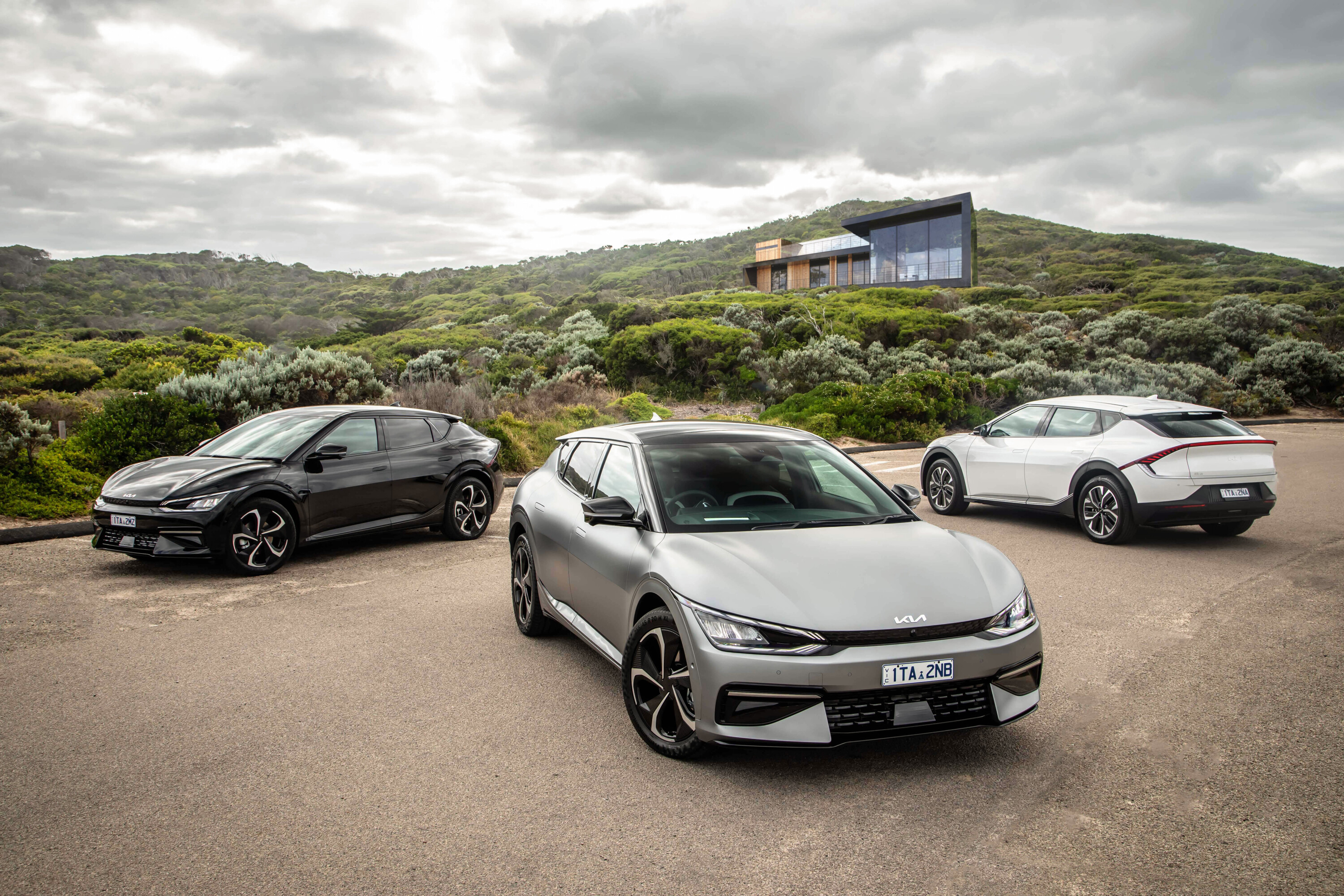
Which version of the Kia EV6 does Wheels recommend?
Our pick is the EV6 GT-Line RWD as it includes most comfort and convenience features, supportive seats, and enough power without compromising too much on driving range.
The base EV6 Air is also commendable as the model with the longest range and pricing closer-ish to the popular Tesla Model Y RWD. But, it has harder seats, loses out on niceties and more accessible auto pop out door handles.
Critically, the $8000 jump from the GT-Line RWD to the AWD is quite steep for the added power, traction, and inclusion of a sunroof.
Then, the GT electric supercar is a headline-grabber. Yet, for six-figures drive-away, it’s cosmetically similar to the GT-Line, omits some features, and is best suited to the closed-circuit track – if you truly want to exploit its capabilities safely and legally.
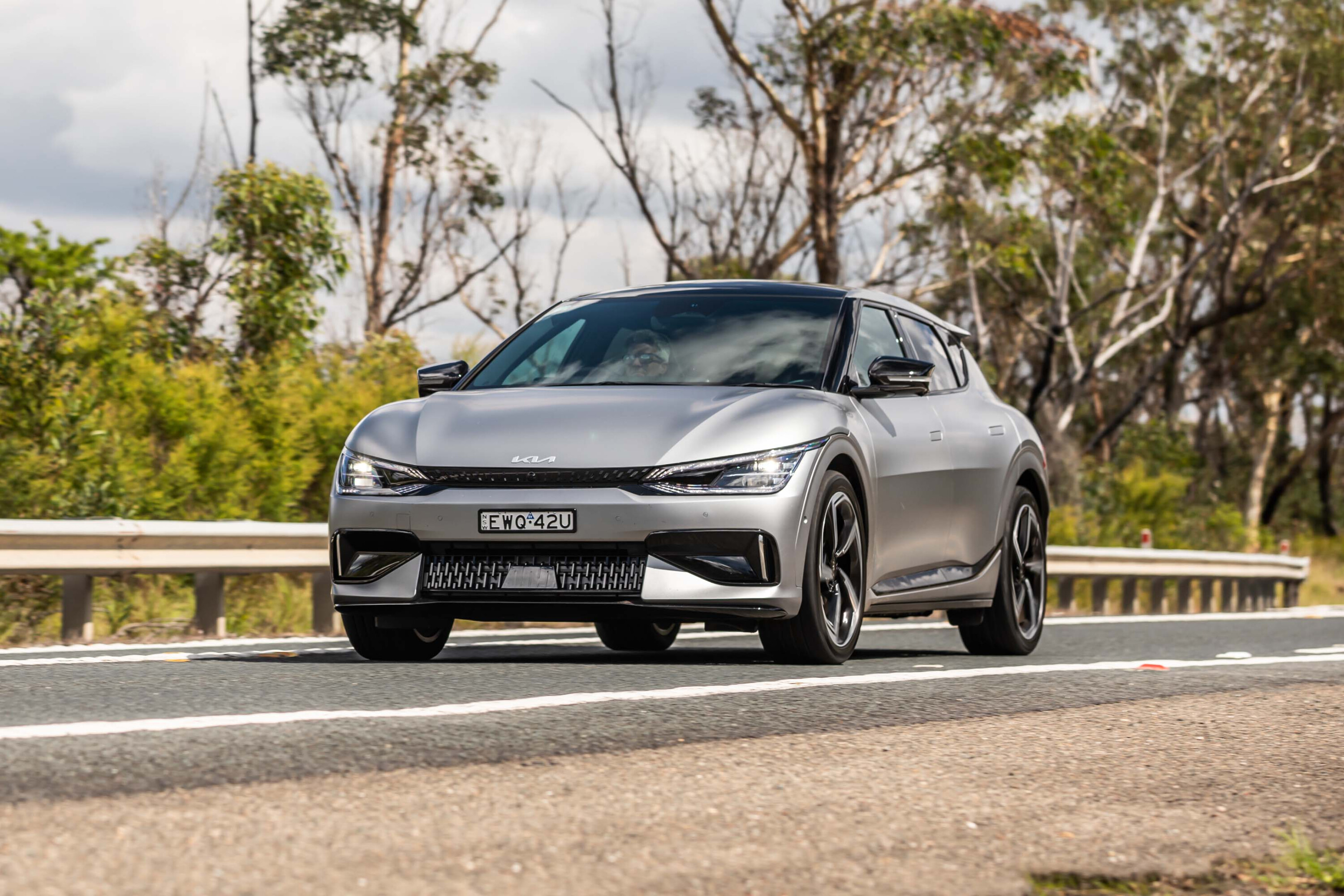
What are the Kia EV6’s key rivals?
The Kia EV6 competes in a highly contested segment of electric medium SUVs, including:
- Tesla Model Y
- Hyundai Ioniq 5
- Volvo C40 Recharge
- Ford Mustang Mach-E (coming soon)
- Toyota BZ4x (coming soon)
- Subaru Solterra (coming soon)
- Renault Megane E-Tech (coming soon)
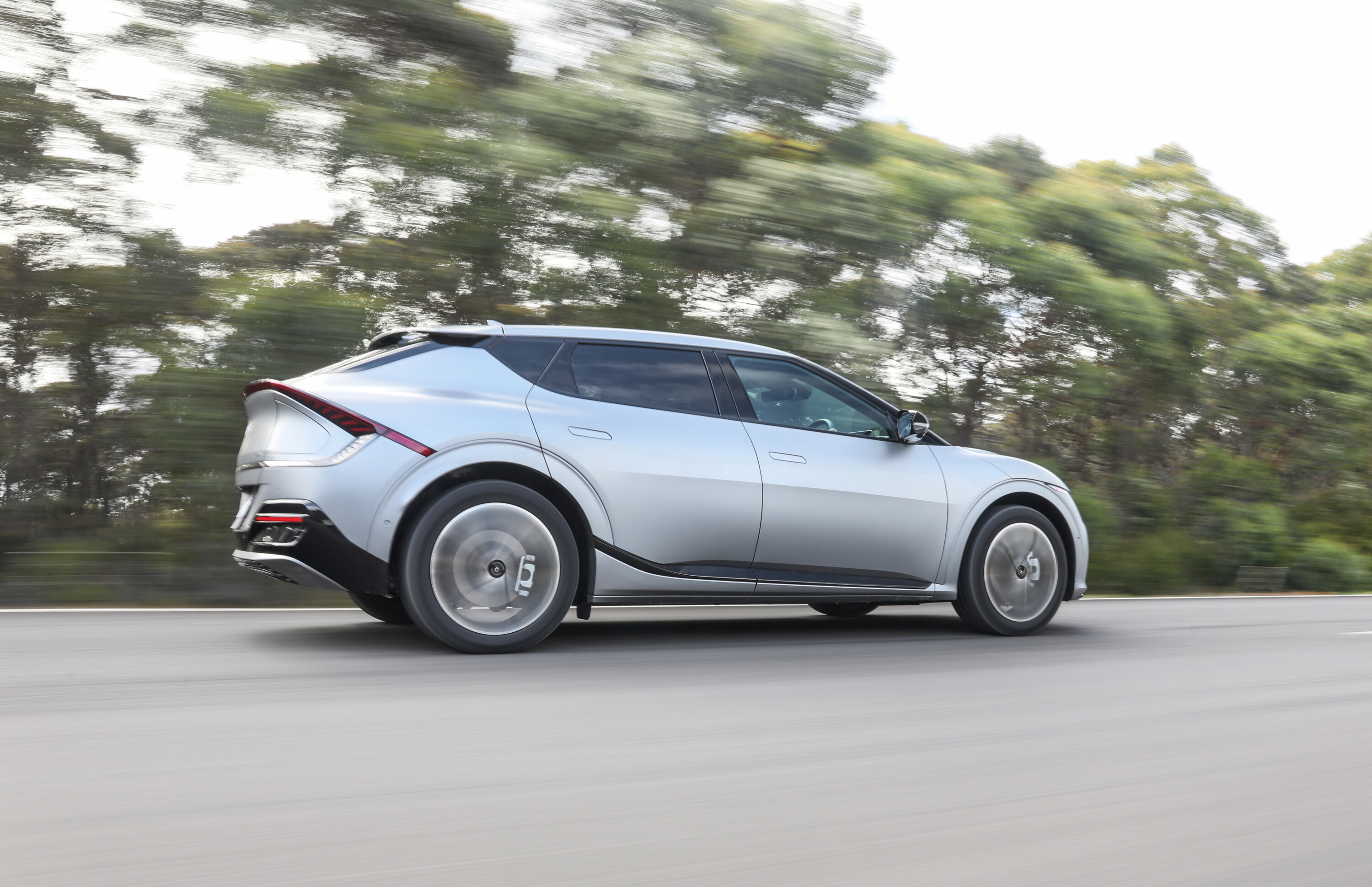
What might annoy me?
In addition to compromising the boot, the Kia EV6’s lower roof means front occupants may feel closer to the ceiling than in other electric SUVs, such as the related Hyundai Ioniq 5.
The higher floor to accommodate the battery also means rear passengers’ knees are higher up than typical engine-powered family SUVs, although this is a trait found on many other EVs.
Additionally, the flush door handles of the base Air model don’t automatically pop out as they do in the Tesla Model Y, which could pose an accessibility issue.”

Meanwhile, the GT-Line and GT’s use of prominent gloss black surfaces on the centre console and interior door grab is fingerprint-prone and easy to scuff with minor scratches over time.
The Hyundai group’s lane-keep assist system may also annoy some driver’s as it tends to tug the wheel when travelling above 60km/h. This is easy to turn off at the steering wheel, though.
The charging port is also uniquely positioned beside the right of the tailgate, which can be tricky for some cables to reach at some side-positioned public charging stations.
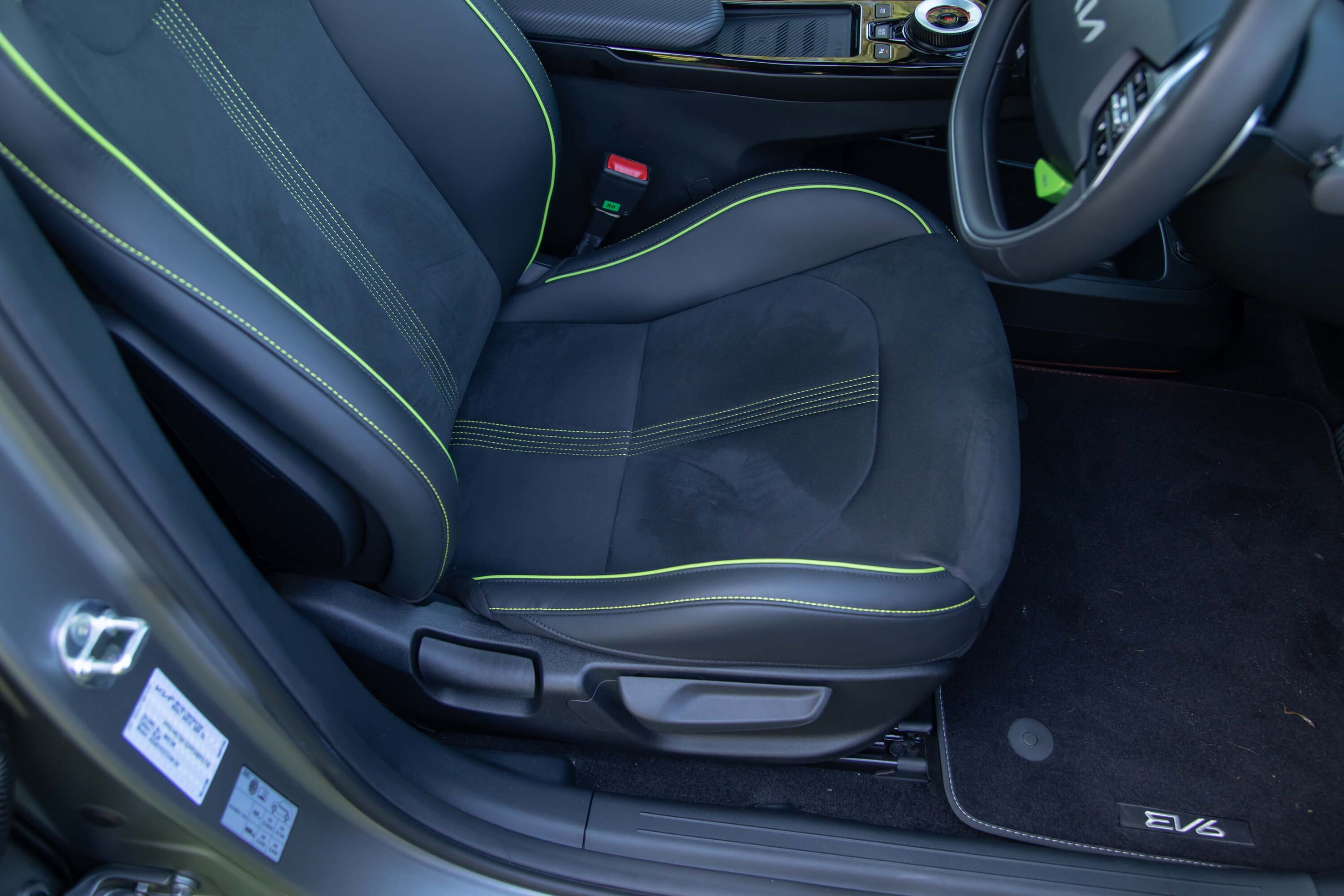
Does any upgrade have a down side?
The higher up you go in the EV6 line-up, the less driving range you get. Larger wheels and more power all demand more energy.
Opting for the hero GT model loses out on some features due to the sporty front bucket seats, including; electric adjustment, lumbar support, ventilation functionality, the reclining relaxation mode, and driver’s seat memory with auto dip-down wing mirrors when reversing.
All AWD drivetrains have restricted frunk storage – 32-litres less than RWD versions due to the added motor up front.
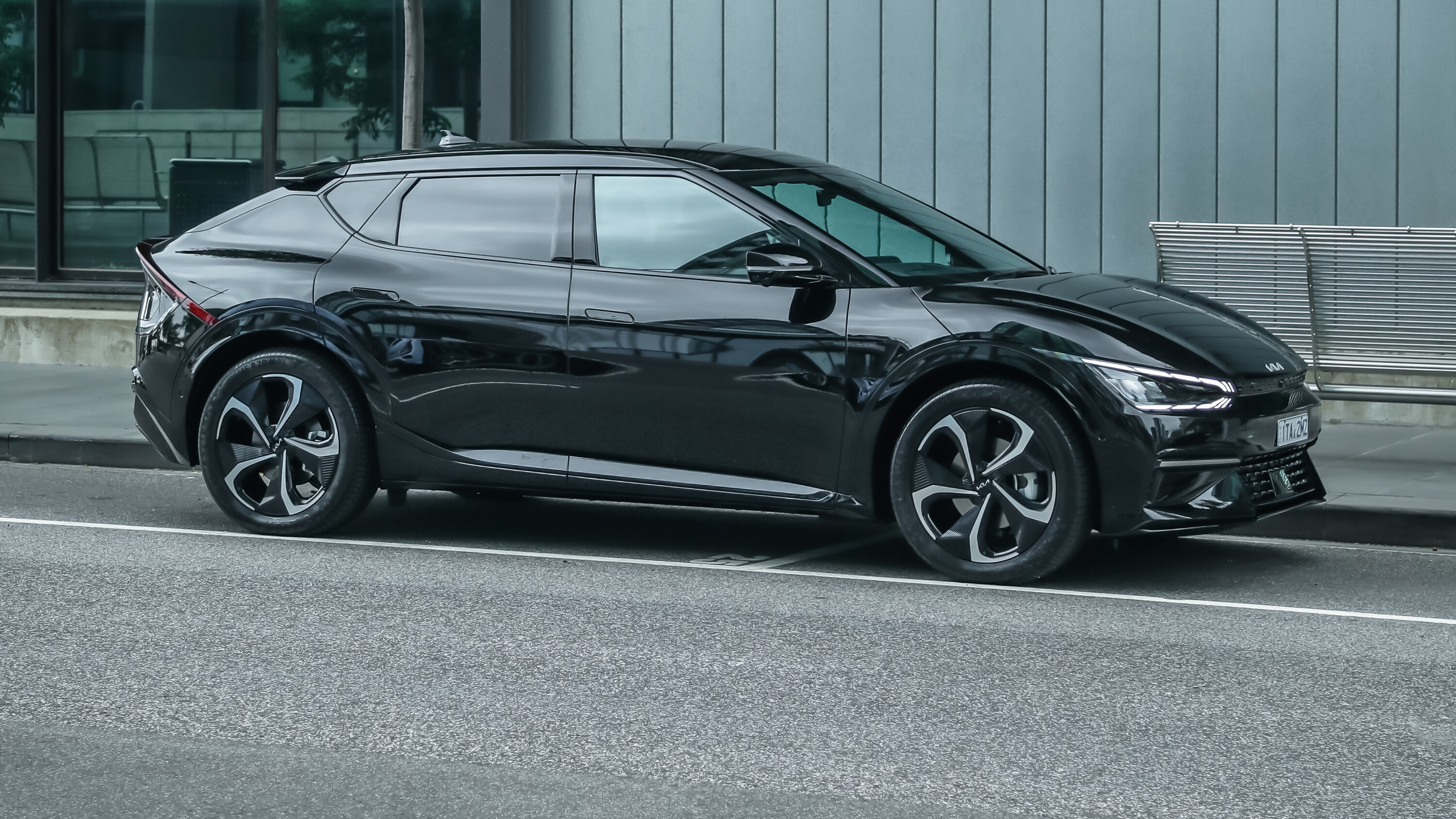
What might I miss that similar cars have?
Unlike the Tesla Model Y, the EV6 doesn’t offer built-in cellular connectivity for connected services and a smartphone app.
Kia Connect – which is standard on the cheaper Niro EV – offers automatic emergency services calling, built-in voice control, and the remote mobile app can handily monitor the EV’s battery percentage state and pre-start the climate control.
As a result, the EV6’s touchscreen isn’t capable of over-the-air (OTA) software updates. It also lacks wireless smartphone projection.
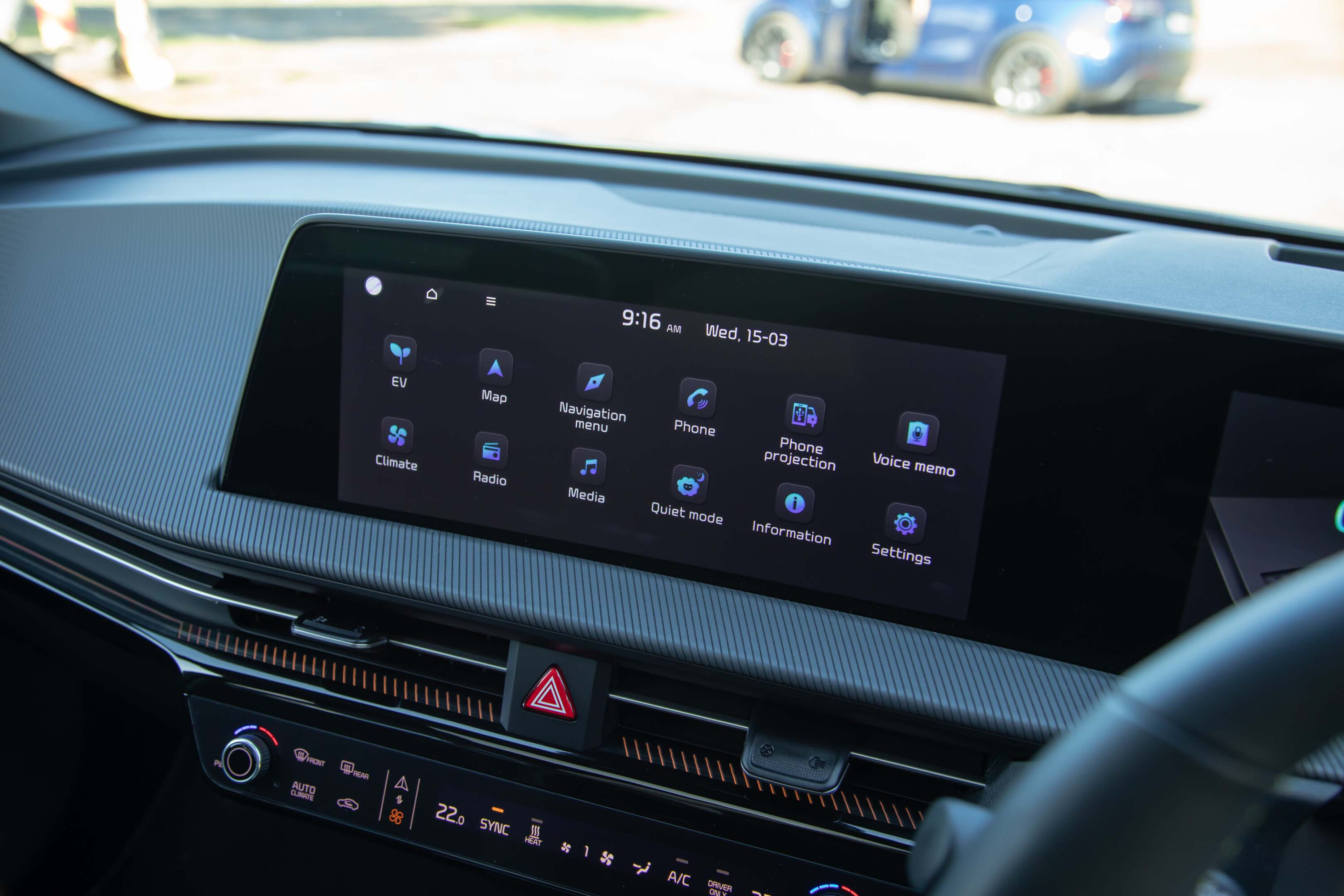
What’s the infotainment system like?
The Kia EV6’s 12.3-inch wide curved touchscreen looks modern and performs well.
It’s mostly easy to use, except for the clunky built-in maps which makes finding destinations tricky. Light and dark modes are available, alongside a blue light filter.
The current model only features wired Apple CarPlay and wired Android Auto via the single USB-A port in front of the centre console.
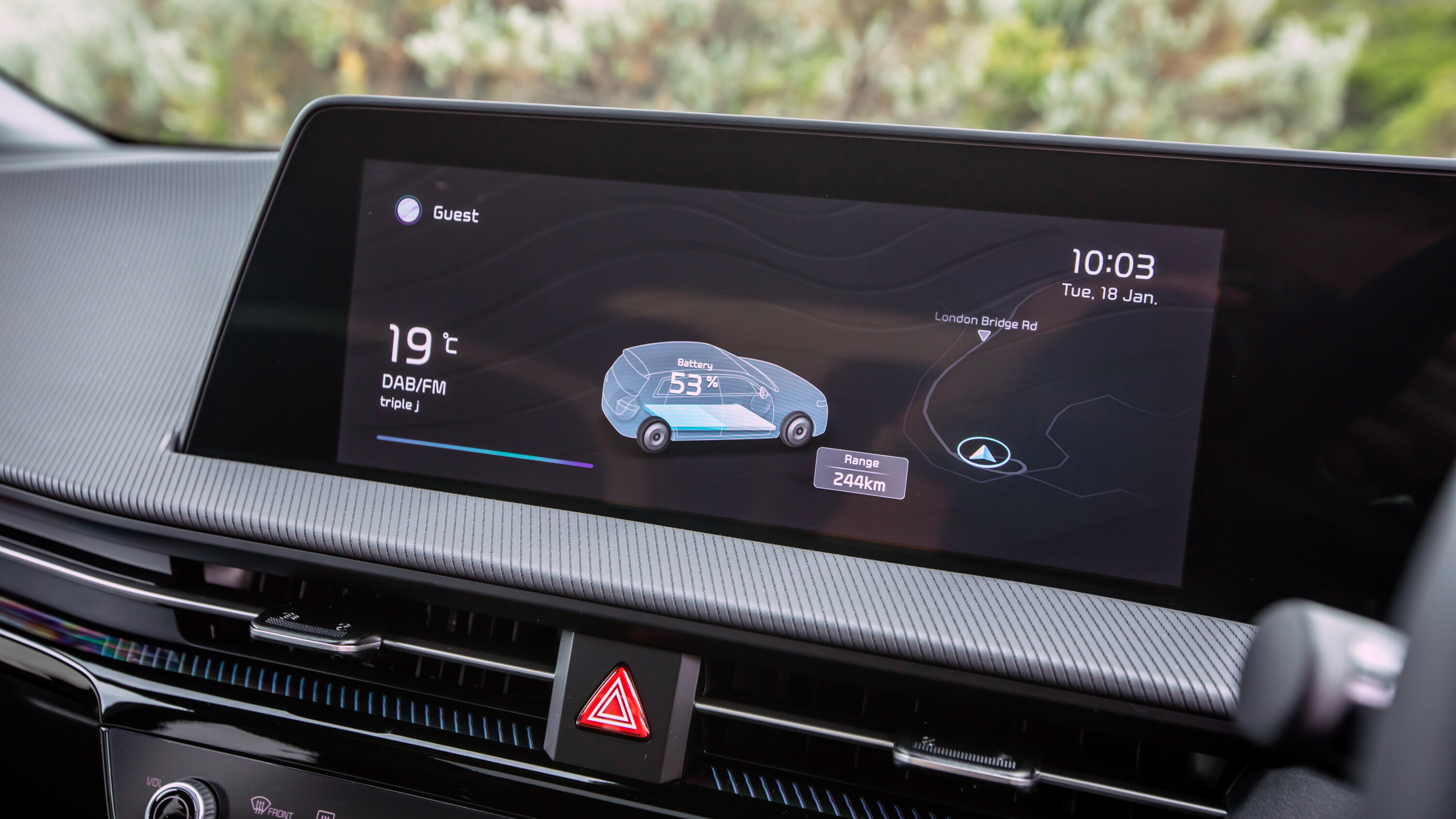
However, the latest operating system from the Hyundai group – which will soon debut in the Kia EV9 large electric SUV – has a more modern revamped user interface and, importantly, wireless smartphone projection.
Meanwhile, the driver’s instrument display is clear and legible, although it doesn’t offer much customisation besides changing between menus and colours when switching drive modes. An augmented reality head-up display is standard on GT-Line and up.
A touchscreen strip doubles up as both the climate control and media controls. It’s better than pushing functions into the infotainment, but the touch buttons and dials are on the smaller side, and switching between the two control functions can be tedious while driving.
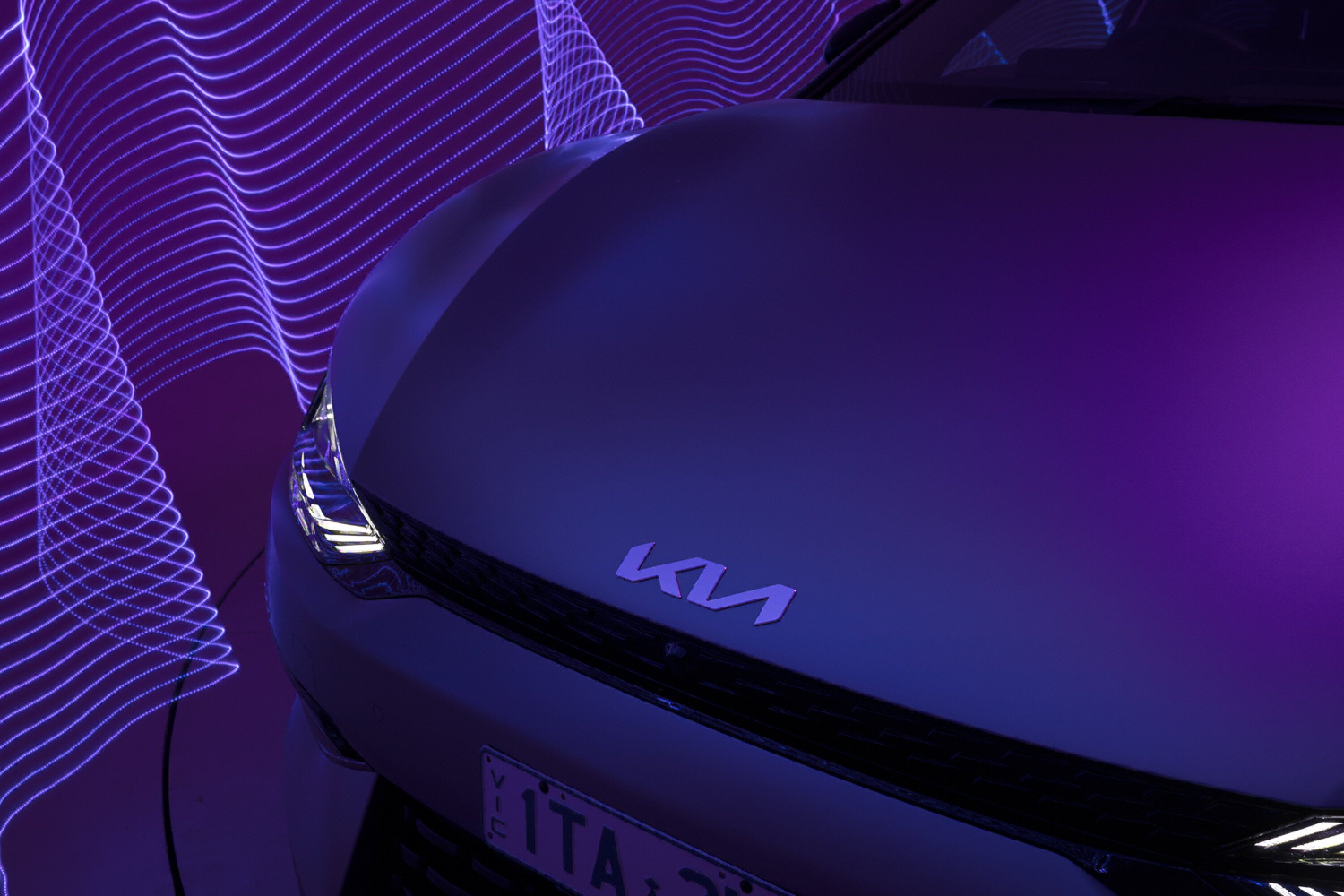
Where does Kia make the EV6?
The Kia EV6 is manufactured in Hwasung, South Korea.
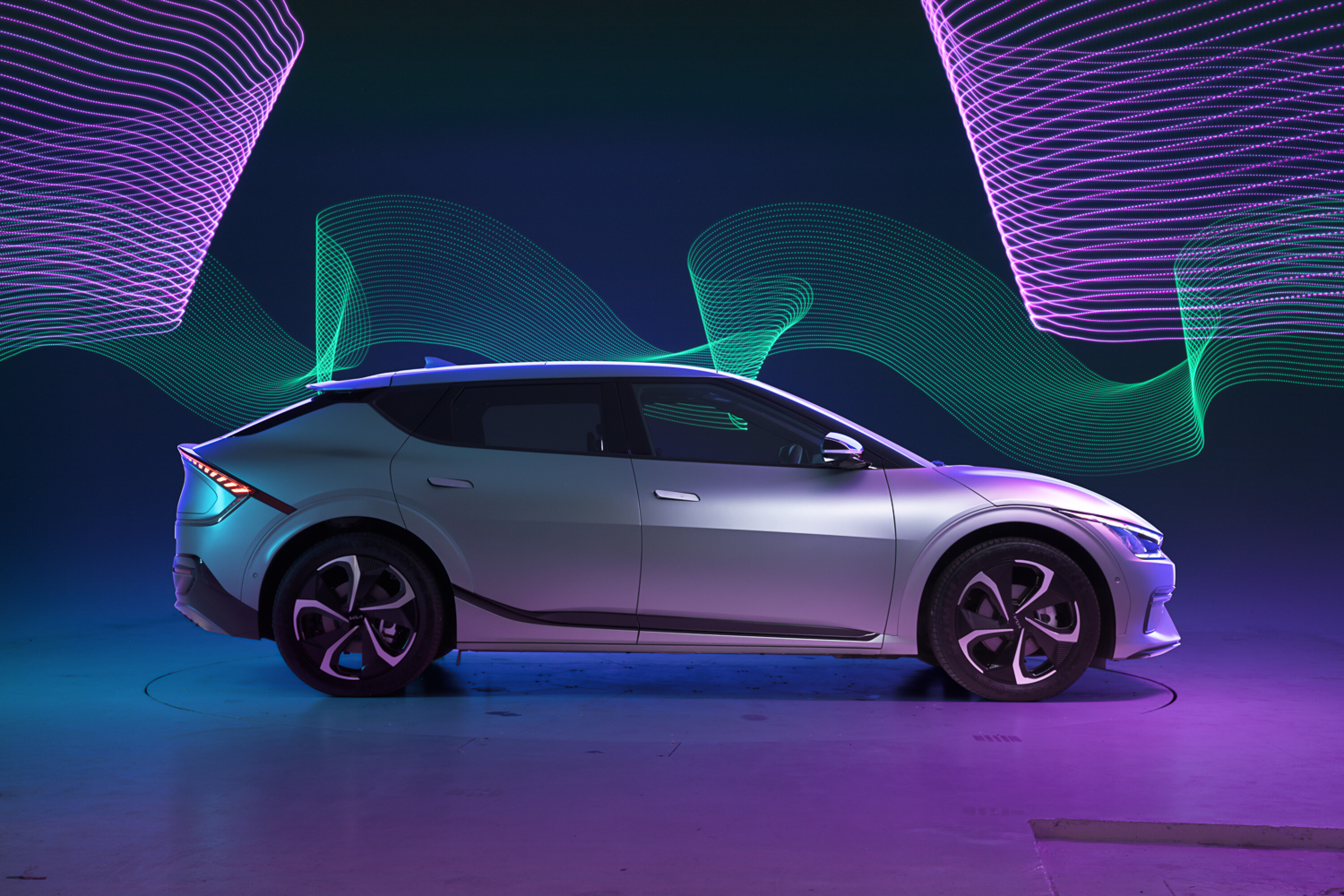
Are there plans to update the Kia EV6 soon?
The Kia EV6 launched in 2021. Judging by typical product life cycles, it could be due for a mid-life facelift in 2024 or 2025.
A camouflaged EV6 has been spotted testing in South Korea, so an update is likely in the works.
It’s likely to bring Kia Connect to Australian models and, if the high performance Hyundai Ioniq 5 N is anything to go by, the EV6 update may also introduce the automaker’s latest Connected Car Navigation Cockpit (ccNC) touchscreen software with wireless smartphone projection.
Additionally, it could also carry the Ioniq 5 N’s larger fourth-generation 84kWh gross battery pack (up from the current 77kWh gross) to extend driving range.
More EV stories to help you choose the best car for your needs
- ? EV news, reviews, advice & guides
- ❓ Short & sweet: Your EV questions answered
- ⚡ New EVs: Everything coming to Australia
- ? Australia’s EVs with the longest driving range
- ⚖️ Best-value EVs by driving range
- ? How much do EVs cost in Australia?
- ? How much more expensive are EVs?
- ⚖️ Number crunching: Is it time to switch to an EV?
- ♻ Should you buy a used EV?
- ?️ Are EVs more expensive to insure?
- ? Costs compared: Charging an EV vs fueling a car
- ? EV charging guide
- ? Are there enough EV chargers in Oz?
- ?? EV servicing explained
- ? EV battery types explained
- ? When do EV batteries need replacing?
- ? Hydrogen v EVs: What’s best for Oz?
- ? How sustainable are EVs, really?
MORE advice stories to help you with buying and owning a car
Score breakdown
Things we like
- Sporty, modern design
- Excellent locally-tuned ride and handling
- Good performance, features across the range
- Ultra-rapid charging capability standard
- GT is a ludicrous family-friendly supercar
Not so much
- Pricey $8K jump from GT-Line RWD to AWD
- Flagship GT missing some comfort features
- Boot, headroom could be better
- No advanced app connectivity
We recommend
-
 Advice
AdviceIs it time to buy an electric car? Crunching the numbers!
Is the tide turning for EVs? We've crunched the numbers on how much you could save by making the electric switch
-
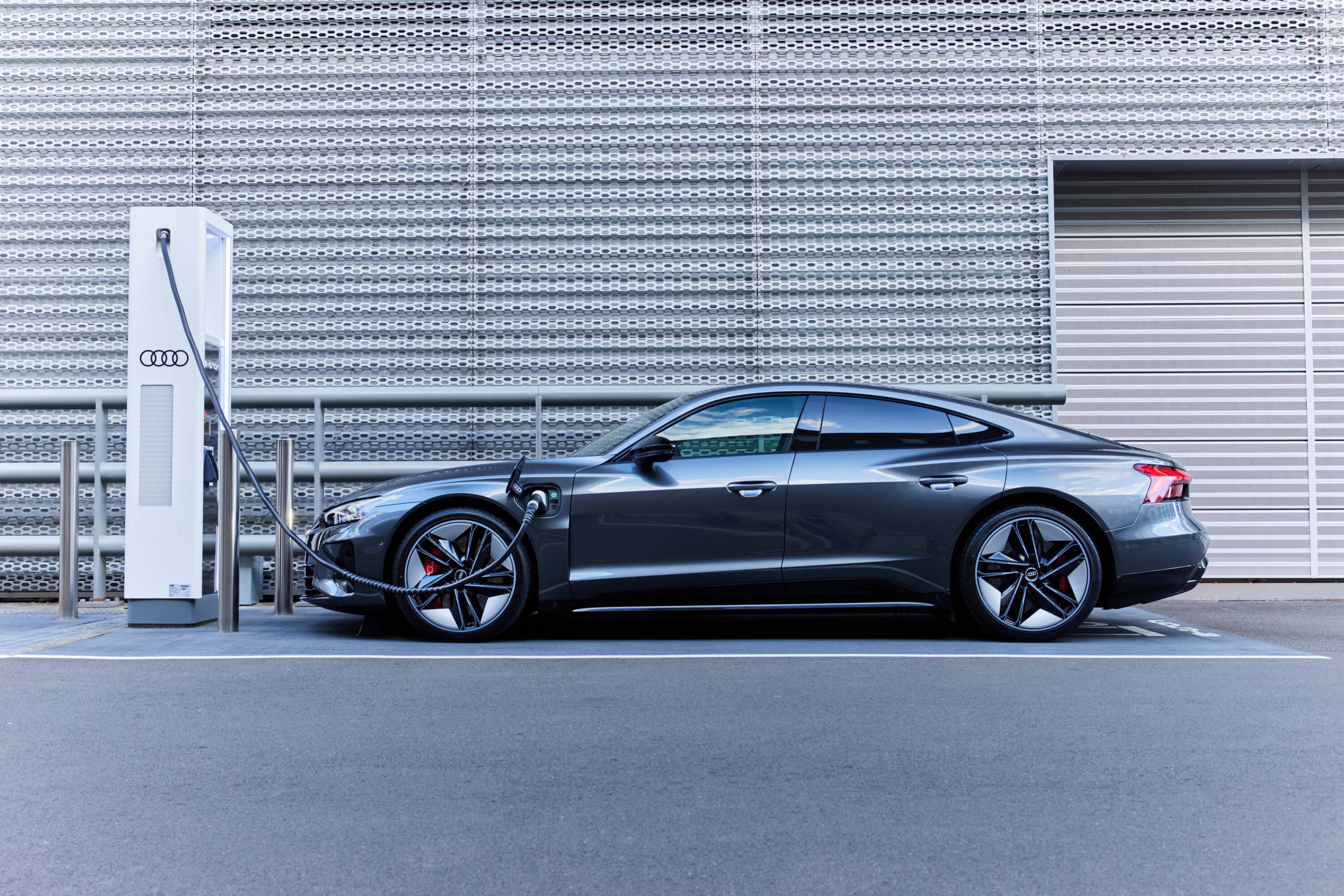 Advice
AdviceThese are the fastest-charging electric cars, if you're in a hurry
These are the quickest charging EVs in Australia, and why higher numbers isn't always best
-
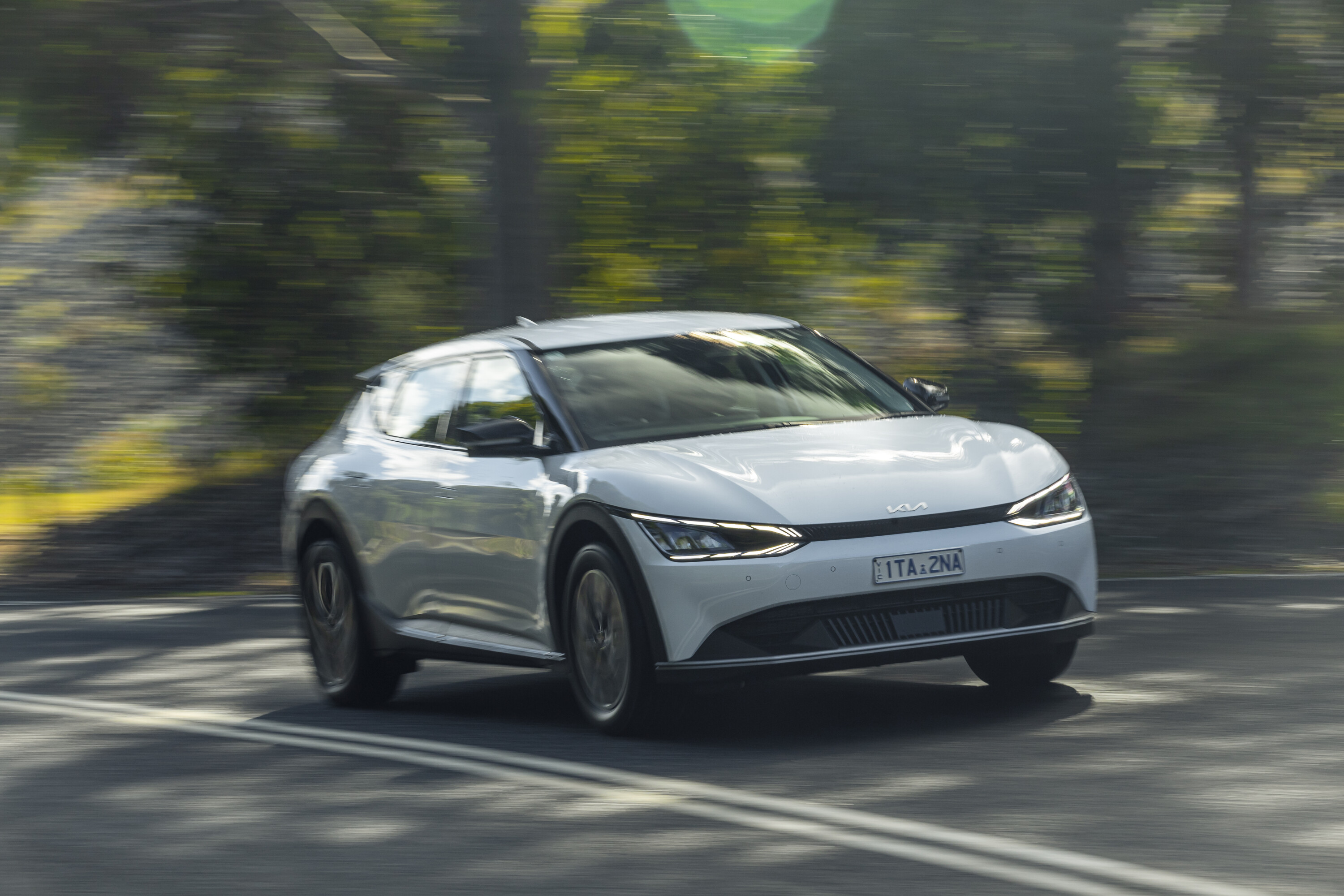 Reviews
Reviews2023 Kia EV6 Air review
Does the entry-level version of Kia’s EV6 electric car impress as much as the GT-Line?


